Paul van Yperen's Blog, page 434
December 20, 2013
J'accuse! (1919)
In less than two weeks it will be 2014 and it will be 100 years ago that the First World War started.
European Film Gateway 1914
is an interesting digitisation project focusing on films and non-film material from and related to World War I. 26 partners, among them 21 European film archives, are digitalising 661 hours of film and ca. 5.600 film-related documents on the theme of the First World War. And it's all free accessible, so check it out.
The pacifist First World War drama J'accuse!/I Accuse (1919) is one of the silent masterpieces by French film director Abel Gance. Work on the film began in 1918 and some scenes were filmed on real battlefields.

French postcard by Cinémagazine, no. 59. Photo: Film Abel Gance. Still for J'accuse (Abel Gance, 1919) with Séverin-Mars .

French postcard by Sadag de France Imp., Paris, no. 109. Still for J'accuse (Abel Gance, 1919) with Romuald Joubé .

French postcard by Sadag de France Imp., Paris, no. 109. Still for J'accuse (Abel Gance, 1919) with Séverin-Mars
Experiencing the Horrors of the War
In J'accuse! Séverin-Mars plays the stubborn brute François Laurin, who lives in a Provençal village in the south of France. He maltreats his wife Edith (Maryse Dauvray), while she feels more for the gentle poet Jean Diaz ( Romuald Joubé ).
When the war breaks out in 1914, the villagers welcome the declaration of war with Germany and flock to enlist. The threesome seems to explode.
The two men meet again in the trenches and experience the horrors of the war. Laurin saves Diaz’ life and sacrifices himself for the benefit of the other two.
Edith is raped by a German soldier. She returns to the village with the fruit of this encounter. She raises the child despite hostility.
Maddened, Diaz returns from the trenches, despises his art and asks the village inhabitants: was it worthwhile, all the sacrifices, while the ghosts of the killed soldiers march up to them.
This sequence of the 'return of the dead' was shot in the south of France, using 2000 soldiers who had come back on leave.
The technical quality of the film was impressive, especially the cinematography of Léonce-Henry Burel with its subtle use of lighting effects and a mobile camera. For the battle scenes in the last section of the film Gance also introduced some of the techniques of rapid editing which he would develop much further in his later films La Roue (1923) and Napoléon (1927).
J’accuse!/I Accuse was released in France in April 1919, only a few months after the Armistice. The film was a great success with the public, whose mood in the aftermath of the war it seemed to capture.

French postcard by Sadag de France Imp., Paris, no. 109. Photo: publicity still for J'accuse (Abel Gance, 1919) with Romuald Joubé and Maryse Dauvray.

French postcard by Sadag de France, Imp., Paris, no. 109.f Photo: publicity still for J'accuse (Abel Gance 1919), starring Séverin-Mars . Here he is one of the ghosts of the dead soldiers who resurrect at the end of the film, and come to the survivors, asking them whether the war was worth fighting for.
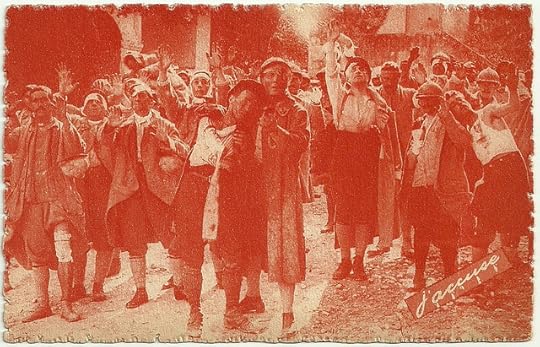
French postcard by Sadag de France, Paris, no. 109. The resurrection of the dead soldiers in J'accuse (1919).
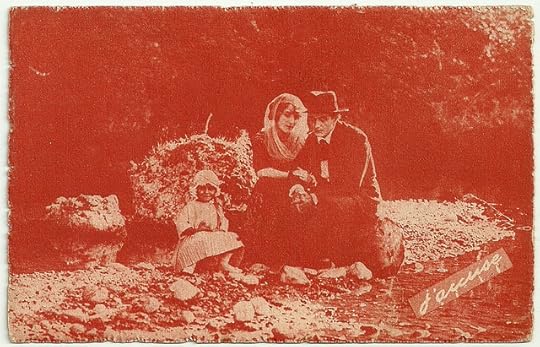
French postcard by Sadag de France, Paris, no. 109. Photo: Edith (Marise Dauvray), Jean Diaz ( Romuald Joubé ) and little Angele (Angèle Guys) towards the end of J'accuse (1919).
Sources: Wikipedia and IMDb.
The pacifist First World War drama J'accuse!/I Accuse (1919) is one of the silent masterpieces by French film director Abel Gance. Work on the film began in 1918 and some scenes were filmed on real battlefields.

French postcard by Cinémagazine, no. 59. Photo: Film Abel Gance. Still for J'accuse (Abel Gance, 1919) with Séverin-Mars .

French postcard by Sadag de France Imp., Paris, no. 109. Still for J'accuse (Abel Gance, 1919) with Romuald Joubé .

French postcard by Sadag de France Imp., Paris, no. 109. Still for J'accuse (Abel Gance, 1919) with Séverin-Mars
Experiencing the Horrors of the War
In J'accuse! Séverin-Mars plays the stubborn brute François Laurin, who lives in a Provençal village in the south of France. He maltreats his wife Edith (Maryse Dauvray), while she feels more for the gentle poet Jean Diaz ( Romuald Joubé ).
When the war breaks out in 1914, the villagers welcome the declaration of war with Germany and flock to enlist. The threesome seems to explode.
The two men meet again in the trenches and experience the horrors of the war. Laurin saves Diaz’ life and sacrifices himself for the benefit of the other two.
Edith is raped by a German soldier. She returns to the village with the fruit of this encounter. She raises the child despite hostility.
Maddened, Diaz returns from the trenches, despises his art and asks the village inhabitants: was it worthwhile, all the sacrifices, while the ghosts of the killed soldiers march up to them.
This sequence of the 'return of the dead' was shot in the south of France, using 2000 soldiers who had come back on leave.
The technical quality of the film was impressive, especially the cinematography of Léonce-Henry Burel with its subtle use of lighting effects and a mobile camera. For the battle scenes in the last section of the film Gance also introduced some of the techniques of rapid editing which he would develop much further in his later films La Roue (1923) and Napoléon (1927).
J’accuse!/I Accuse was released in France in April 1919, only a few months after the Armistice. The film was a great success with the public, whose mood in the aftermath of the war it seemed to capture.

French postcard by Sadag de France Imp., Paris, no. 109. Photo: publicity still for J'accuse (Abel Gance, 1919) with Romuald Joubé and Maryse Dauvray.

French postcard by Sadag de France, Imp., Paris, no. 109.f Photo: publicity still for J'accuse (Abel Gance 1919), starring Séverin-Mars . Here he is one of the ghosts of the dead soldiers who resurrect at the end of the film, and come to the survivors, asking them whether the war was worth fighting for.

French postcard by Sadag de France, Paris, no. 109. The resurrection of the dead soldiers in J'accuse (1919).

French postcard by Sadag de France, Paris, no. 109. Photo: Edith (Marise Dauvray), Jean Diaz ( Romuald Joubé ) and little Angele (Angèle Guys) towards the end of J'accuse (1919).
Sources: Wikipedia and IMDb.
Published on December 20, 2013 23:00
December 19, 2013
Julio Iglesias
Today, it's Postcard Friendship Friday again on the net. A weekly event in which postcard blogs present themselves. Start at Beth's blog with the great title
The Best Hearts Are Crunchy
, and enjoy some rare vintage postcards that are preserved on the net by bloggers like me.
For this Postcard Friendship Friday, I have chosen postcards of Spanish singer and songwriter Julio Iglesias (1943), who sold over 300 million records worldwide. The handsome singer with the powerful voice also starred in a few Spanish feature films.
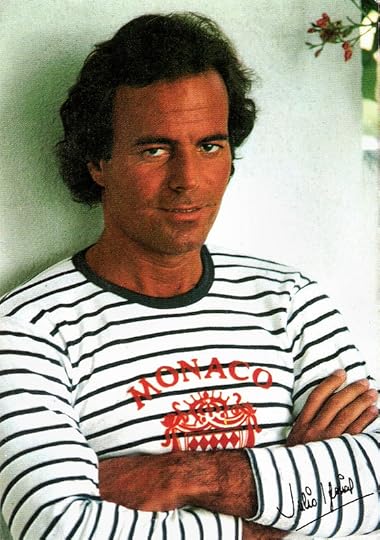
Spanish card by Promotore des Artes Graficas, Barcelona, no. J.I.-5. Sent by mail in 1985. Photo: Julio Iglesias Difusión / P.A.G.S.A., 1982.
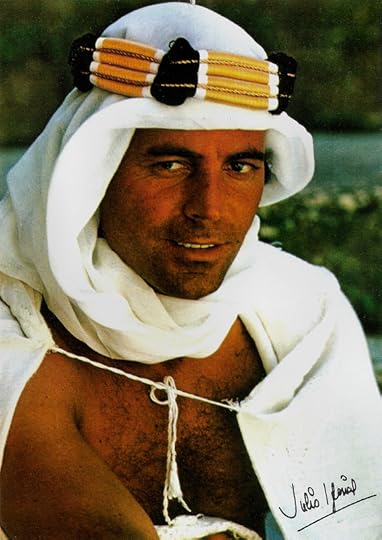
Spanish card by Promotore des Artes Graficas, Barcelona, no. J.I.-7. Photo: Julio Iglesias Difusión / P.A.G.S.A., 1982.
Life Goes On
Julio Iglesias was born Julio José Iglesias de la Cueva in Madrid in 1943. His parents were Julio Iglesias, Sr., a gynecologist, and Maria del Rosario de la Cueva y Perignat.
As a teenager he achieved one of his great dreams when he was recruited to play goalkeeper for his favourite soccer team, Real Madrid. He alternated playing professional soccer with law studies at the Colegio Mayor Universitario San Pablo in Madrid.
He was due just one course to finish his study when he had a serious car accident in 1962. He was unable to walk for two years, and the car crash finished his professional football career. During his two year hospitalization after the accident, a nurse gave him a guitar to have something to do with his hands. In learning to play, he discovered his musical talent and began writing songs.
In 1968, he won the Benidorm International Song Festival, an annual songwriter's event in Spain, with the song La vida sigue igual (Life Goes On). The song became a number one hit in Spain and he sang it also in the film La vida sigue igual/Life Goes On (Eugenio Martín, 1969), about his own life.
Iglesias signed a deal with Discos Columbia, the Spanish branch of Columbia Records. In 1970, he represented Spain at the Eurovision Song Contest, finishing in fourth place, behind Ireland's winning entry performed by Dana. His entry was the song Gwendolyne.
Shortly after he had a number one hit in many European countries with Un Canto A Galicia. That single sold 1 million copies in Germany.
Soon he was one of the most popular musical performers throughout Europe, performing for tens of thousands of fans in most of the world's capitals. In 1975 he found success in the Italian market by recording a song exclusively in Italian called Se mi lasci non vale (If You Leave Me, It Can't Be).
He also sang in French. One of his popular songs is Je n'ai pas change (I have not changed). In 1976, Iglesias played a sold-out concert at Madison Square Garden in New York City.
Notable albums from this decade are Soy (1973), A Flor de Piel (1974, with the European hit Manuela), and El Amor (1975). He also starred in another film, Me olvidé de vivir/I forgot to live (Orlando Jiménez Leal, 1980) with Carol Lynley.
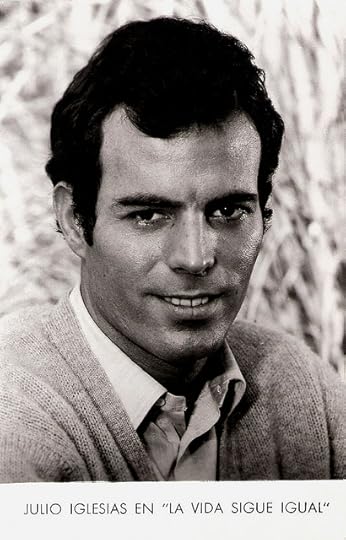
Spanish card. Photo: publicity still for La vida sigue igual/Life Goes On (Eugenio Martín, 1969).
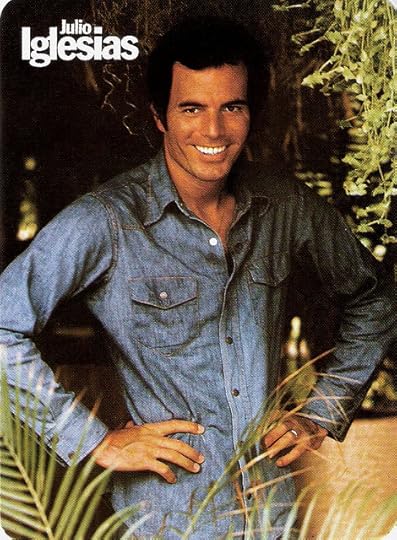
German collector's card by Philips.
A Man Alone
Following the annulment of his first marriage to TV host Isabel Preysler in 1979, Julio Iglesias set his sights on conquering the English-language markets.
He signed a deal with CBS International, and released the album De Niña a Mujer (From Girl To Woman) (1981), dedicated to his daughter. It contained his first English-language hit, Begin the Beguine which became number 1 in the United Kingdom.
In 1984, he released 1100 Bel Air Place, the hit album which gave him publicity in the English-speaking entertainment industry. It sold four million albums in the United States. The first single To All the Girls I've Loved Before, a duet with Willie Nelson, earned a fifth place spot in the Billboard Hot 100. The album also featured All of You, with Diana Ross.
In 1985, after Basque terrorists had kidnapped his father, Iglesias moved to Miami, Florida. At the 1988 Grammy Awards, he won a Grammy for Best Latin Pop Album for the album Un Hombre Solo (A Man Alone). He recorded a duet with Stevie Wonder on My Love for his Non Stop album, a crossover success in 1988.
His songs were used on the soundtracks of several films, including the comedy Moon Over Parador (Paul Mazursky, 1988) with Richard Dreyfuss, and the Spanish comedy-drama Huevos de oro/Golden Balls (Bigas Luna, 1993) starring Javier Bardem.
Iglesias made a cameo appearance as himself on the TV series The Golden Girls as Sophia Petrillo's date on St. Valentine's Day 1989.
In the 1990s, Iglesias returned to his Latin roots with the album Tango (1996), nominated for Best Latin Pop Album at the 1998 Grammy Awards.
His youngest son from his first marriage, Enrique Iglesias, also was nominated for the Vivir album, but both lost to singer Luis Miguel. Julio Iglesias went on to win the World Music Award for Tango in Monaco later that year where he was up against Luis Miguel and Enrique for the second time.
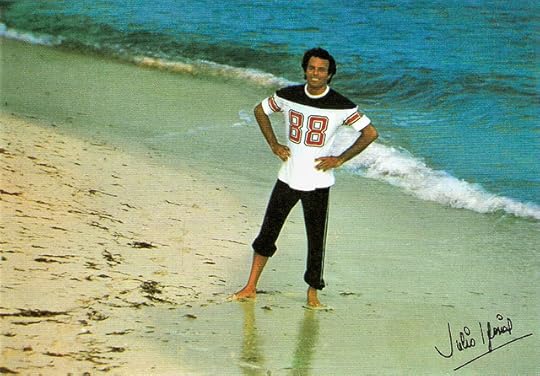 Spanish card by Promotore des Artes Graficas, Barcelona, no. J.I.-16. Photo: Julio Iglesias Difusión / P.A.G.S.A., 1982.
Spanish card by Promotore des Artes Graficas, Barcelona, no. J.I.-16. Photo: Julio Iglesias Difusión / P.A.G.S.A., 1982.

Spanish card by Promotore des Artes Graficas, Barcelona, no. J.I.-8. Sent by mail in 1984. Photo: Julio Iglesias Difusión / P.A.G.S.A., 1982.
Numero 1
In 2001, Julio Iglesias finished his law degree at the Complutense University in Madrid. He had promised his old father that he would eventually graduate after dropping out 35 years earlier to pursue his music career.
In 2003, Iglesias released his album Divorcio (Divorce). In its first day of sales, Divorcio sold a record 350,000 albums in Spain, and reached the number 1 spot on the charts in Spain, Portugal, France, Italy, and Russia.
In 2003 and 2004, he was featured on a ten month world tour. In 2006, a new English album titled Romantic Classics was released. In March 2011, the artist launched a new studio album called Numero 1. Iglesias' performance of the song La Mer (The Sea) was featured on the soundtrack of the film Tinker Tailor Soldier Spy (Tomas Alfredson, 2011) starring Gary Oldman and Colin Firth.
Julio Iglesias married twice. From 1971 till 1979, he was married to Isabel Preysler with whom he has a daughter, Chabeli Iglesias and two sons, Julio Iglesias Jr. and Enrique Iglesias. All three are singers and actors in their own right.
In 2010, he married his girlfriend of 20 years, Miranda Rijnsburger, in a traditional Catholic Wedding. They have five children. Iglesias has one granddaughter named Sofia Iglesias who is his daughter Chabeli's child.
Mark Deming at AllMusic : “While he maintained a busy performing schedule, Iglesias seemed to be slowing down his recording commitments after the release of 2006's Romance Classics, but in 2011, declaring his voice to be as strong as it had been in his youth, he re-recorded a number of his best-known songs for a new collection, titled Vol. 1, which was a major commercial success.”
In a career that has spanned six decades now, the international superstar has sold over 300 million albums worldwide.
Julio Iglesias sings the title song of Me olvidé de vivir/I forgot to live (Orlando Jiménez Leal, 1980).
Sources: Mark Deming (AllMusic), JulioIglesias.com, Wikipedia and .
For this Postcard Friendship Friday, I have chosen postcards of Spanish singer and songwriter Julio Iglesias (1943), who sold over 300 million records worldwide. The handsome singer with the powerful voice also starred in a few Spanish feature films.

Spanish card by Promotore des Artes Graficas, Barcelona, no. J.I.-5. Sent by mail in 1985. Photo: Julio Iglesias Difusión / P.A.G.S.A., 1982.

Spanish card by Promotore des Artes Graficas, Barcelona, no. J.I.-7. Photo: Julio Iglesias Difusión / P.A.G.S.A., 1982.
Life Goes On
Julio Iglesias was born Julio José Iglesias de la Cueva in Madrid in 1943. His parents were Julio Iglesias, Sr., a gynecologist, and Maria del Rosario de la Cueva y Perignat.
As a teenager he achieved one of his great dreams when he was recruited to play goalkeeper for his favourite soccer team, Real Madrid. He alternated playing professional soccer with law studies at the Colegio Mayor Universitario San Pablo in Madrid.
He was due just one course to finish his study when he had a serious car accident in 1962. He was unable to walk for two years, and the car crash finished his professional football career. During his two year hospitalization after the accident, a nurse gave him a guitar to have something to do with his hands. In learning to play, he discovered his musical talent and began writing songs.
In 1968, he won the Benidorm International Song Festival, an annual songwriter's event in Spain, with the song La vida sigue igual (Life Goes On). The song became a number one hit in Spain and he sang it also in the film La vida sigue igual/Life Goes On (Eugenio Martín, 1969), about his own life.
Iglesias signed a deal with Discos Columbia, the Spanish branch of Columbia Records. In 1970, he represented Spain at the Eurovision Song Contest, finishing in fourth place, behind Ireland's winning entry performed by Dana. His entry was the song Gwendolyne.
Shortly after he had a number one hit in many European countries with Un Canto A Galicia. That single sold 1 million copies in Germany.
Soon he was one of the most popular musical performers throughout Europe, performing for tens of thousands of fans in most of the world's capitals. In 1975 he found success in the Italian market by recording a song exclusively in Italian called Se mi lasci non vale (If You Leave Me, It Can't Be).
He also sang in French. One of his popular songs is Je n'ai pas change (I have not changed). In 1976, Iglesias played a sold-out concert at Madison Square Garden in New York City.
Notable albums from this decade are Soy (1973), A Flor de Piel (1974, with the European hit Manuela), and El Amor (1975). He also starred in another film, Me olvidé de vivir/I forgot to live (Orlando Jiménez Leal, 1980) with Carol Lynley.

Spanish card. Photo: publicity still for La vida sigue igual/Life Goes On (Eugenio Martín, 1969).

German collector's card by Philips.
A Man Alone
Following the annulment of his first marriage to TV host Isabel Preysler in 1979, Julio Iglesias set his sights on conquering the English-language markets.
He signed a deal with CBS International, and released the album De Niña a Mujer (From Girl To Woman) (1981), dedicated to his daughter. It contained his first English-language hit, Begin the Beguine which became number 1 in the United Kingdom.
In 1984, he released 1100 Bel Air Place, the hit album which gave him publicity in the English-speaking entertainment industry. It sold four million albums in the United States. The first single To All the Girls I've Loved Before, a duet with Willie Nelson, earned a fifth place spot in the Billboard Hot 100. The album also featured All of You, with Diana Ross.
In 1985, after Basque terrorists had kidnapped his father, Iglesias moved to Miami, Florida. At the 1988 Grammy Awards, he won a Grammy for Best Latin Pop Album for the album Un Hombre Solo (A Man Alone). He recorded a duet with Stevie Wonder on My Love for his Non Stop album, a crossover success in 1988.
His songs were used on the soundtracks of several films, including the comedy Moon Over Parador (Paul Mazursky, 1988) with Richard Dreyfuss, and the Spanish comedy-drama Huevos de oro/Golden Balls (Bigas Luna, 1993) starring Javier Bardem.
Iglesias made a cameo appearance as himself on the TV series The Golden Girls as Sophia Petrillo's date on St. Valentine's Day 1989.
In the 1990s, Iglesias returned to his Latin roots with the album Tango (1996), nominated for Best Latin Pop Album at the 1998 Grammy Awards.
His youngest son from his first marriage, Enrique Iglesias, also was nominated for the Vivir album, but both lost to singer Luis Miguel. Julio Iglesias went on to win the World Music Award for Tango in Monaco later that year where he was up against Luis Miguel and Enrique for the second time.
 Spanish card by Promotore des Artes Graficas, Barcelona, no. J.I.-16. Photo: Julio Iglesias Difusión / P.A.G.S.A., 1982.
Spanish card by Promotore des Artes Graficas, Barcelona, no. J.I.-16. Photo: Julio Iglesias Difusión / P.A.G.S.A., 1982.
Spanish card by Promotore des Artes Graficas, Barcelona, no. J.I.-8. Sent by mail in 1984. Photo: Julio Iglesias Difusión / P.A.G.S.A., 1982.
Numero 1
In 2001, Julio Iglesias finished his law degree at the Complutense University in Madrid. He had promised his old father that he would eventually graduate after dropping out 35 years earlier to pursue his music career.
In 2003, Iglesias released his album Divorcio (Divorce). In its first day of sales, Divorcio sold a record 350,000 albums in Spain, and reached the number 1 spot on the charts in Spain, Portugal, France, Italy, and Russia.
In 2003 and 2004, he was featured on a ten month world tour. In 2006, a new English album titled Romantic Classics was released. In March 2011, the artist launched a new studio album called Numero 1. Iglesias' performance of the song La Mer (The Sea) was featured on the soundtrack of the film Tinker Tailor Soldier Spy (Tomas Alfredson, 2011) starring Gary Oldman and Colin Firth.
Julio Iglesias married twice. From 1971 till 1979, he was married to Isabel Preysler with whom he has a daughter, Chabeli Iglesias and two sons, Julio Iglesias Jr. and Enrique Iglesias. All three are singers and actors in their own right.
In 2010, he married his girlfriend of 20 years, Miranda Rijnsburger, in a traditional Catholic Wedding. They have five children. Iglesias has one granddaughter named Sofia Iglesias who is his daughter Chabeli's child.
Mark Deming at AllMusic : “While he maintained a busy performing schedule, Iglesias seemed to be slowing down his recording commitments after the release of 2006's Romance Classics, but in 2011, declaring his voice to be as strong as it had been in his youth, he re-recorded a number of his best-known songs for a new collection, titled Vol. 1, which was a major commercial success.”
In a career that has spanned six decades now, the international superstar has sold over 300 million albums worldwide.
Julio Iglesias sings the title song of Me olvidé de vivir/I forgot to live (Orlando Jiménez Leal, 1980).
Sources: Mark Deming (AllMusic), JulioIglesias.com, Wikipedia and .
Published on December 19, 2013 23:00
December 18, 2013
Gracie Fields
Lusty and loudmouthed Gracie Fields (1898-1979) was a British comedienne on stage and in films, and a singer in music halls. In the 1930s her working-class girl character was a top box office draw and Fields was the best paid actress in Britain, and later in America too.
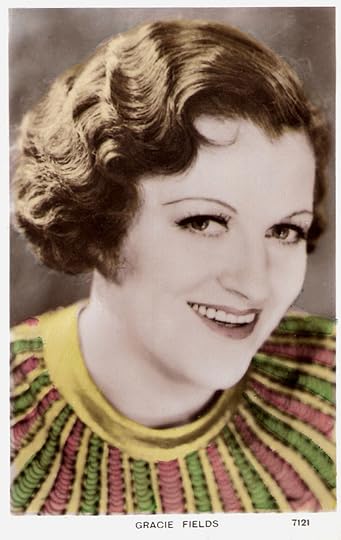
British postcard by Valentine's Postcard, no. 7121.
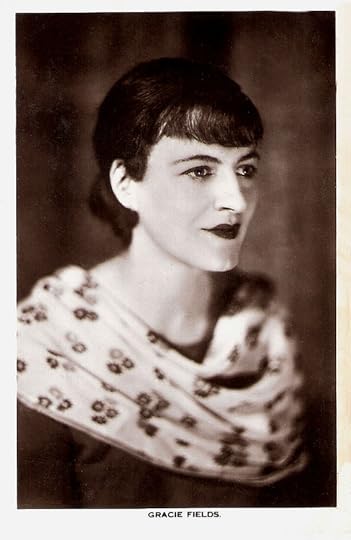
British postcard by Real Photograph, London, in the Picturegoer series, no. 439.
Wildly Popular Music-Hall Singer
Gracie Fields was born as Grace Stansfield over a chip shop owned by her grandmother in Rochdale, Lancashire, in 1898. She started as a child actor in 1905. Her two sisters and brother were all pushed by their mother on stage too, but Gracie proved to be the most successful.
In 1910 she had her professional debut in variety in Rochdale. Five years later Fields met struggling comedian Archie Pitt and joined forces.
Pitt became her manager, and he built a show around her, Tower of London, which toured the provinces for four years. The two married in 1923. With Mr Tower of London, Fields reached the West End in 1924.
She started also a dramatic career and began recording her songs too. Fields became a wildly popular Music-Hall singer with her particular style of “a mixture of self-deprecating jokes, comic songs and monologues, as well as cheerful 'depression-era' songs all presented in a "no-airs-and-graces Northern, working class style”, as Wikipedia writes.
Because of her strong interaction with her audiences, Fields played to sold out theatres all over Britain and she became one of the highest paid performers.
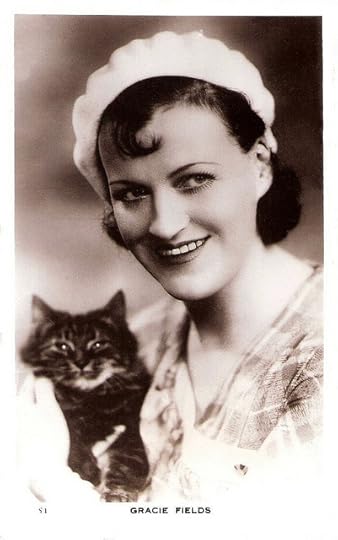
British postcard, no. 51.
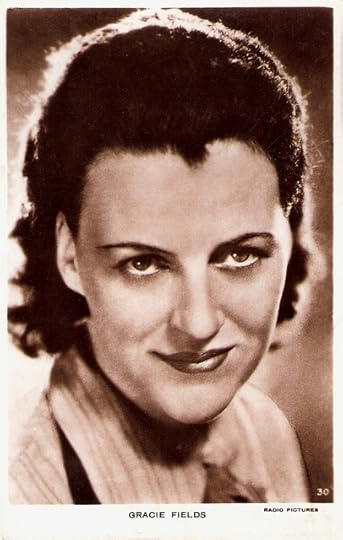 British postcard, no. 30. Photo: Radio Pictures.
British postcard, no. 30. Photo: Radio Pictures.
250,000 Get-Well Cards
In the 1930s Gracie Fields reached the peak of her career and was awarded various honours. Her most famous song was Sally. This was the title song of her first sound film, the First World War drama Sally in Our Alley (Maurice Elvey, 1931), which was an enormous success.
Fields continued to make various films in the UK and the US, though she always preferred to perform in front of a live audience.
After Sally in Our Alley, she continued to make films for the Ealing studios such as This Week of Grace (Maurice Elvey, 1933) with Henry Kendall, Look Up and Laugh (Basil Dean, 1935), and Queen of Hearts (Monty Banks, 1936) with John Loder .
In 1938 she played in a musical comedy set in Australia in the 1880s: We’re Going to Be Rich (Monty Banks, 1938), with Victor McLaglen as Fields’ partner.
Next came two more Banks films, the first still made in the UK, Keep Smiling (Monty Banks, 1938), and the second in the US, Shipyard Sally (Monty Banks, 1939).
After her marriage with Archie Pitt ended, she donated her London house to a maternal hospital.
When she fell ill with cancer in 1939 and retired to her villa in Capri, she was covered in over 250,000 get-well cards. After her recovery she recorded the song Gracie’s Thanks to thank her fans for sending the mail.
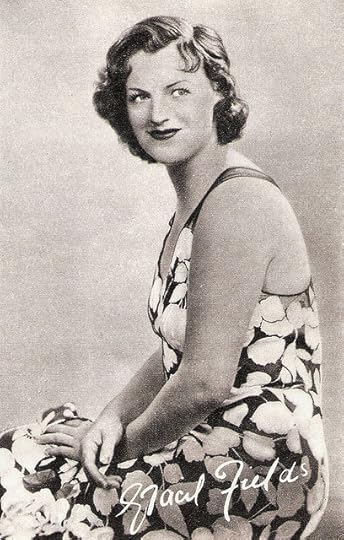
British postcard by Photogravure. Photo: ATP Studios, London.
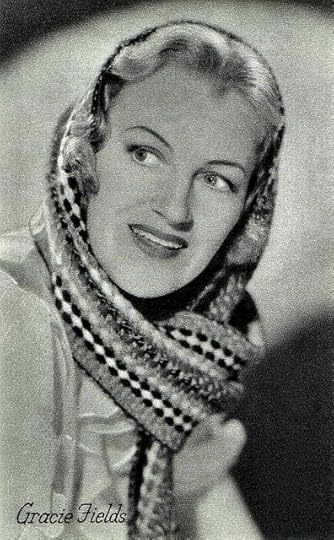
British collector's card.
Miss Marple
In 1940 Gracie Fields married Italian-born film director Monty Banks (Mario Bianco). Because Banks remained an Italian citizen and would have been interned in the United Kingdom, she was forced to leave Britain for America.
The British press and public hooted bitterly. She entertained the Allied troops all over the world.
During the war she played in two American musical comedies with Monty Woolley: Holy Matrimony (John M. Stahl, 1943) and Molly and Me (Lewis Seiler, 1945). She also appeared in the war drama Paris Underground (Gregory Ratoff, 1945) with Constance Bennett.
After the war she returned to Britain in 1948 to perform, but she never regained the heights of her popularity in the 1930s.
Though Fields stopped playing in films, she continued making records. Her last recording, The Golden Years of Gracie Fields, was made in 1975 at age 77.
Between 1956 and 1963, she played for television, including as Agatha Christie's Miss Marple in the American TV-film A Murder is Announced (1956), part of the Goodyear Playhouse Television series.
Fields was also a regular guest in TV shows, including the religiously themed variety show Stars on Sunday (1971).
After the death of Monty Banks in 1950, she married Boris Alperovici, a Romanian radio repairman. In February 1979, Gracie Fields was invested as a Dame Commander of the Order of the British Empire seven months before her death in her villa on Capri, Italy, aged 81.
In 2009, Jane Horrocks portrayed her in the BBC TV production Gracie!, a drama portraying the life of Fields just before and during World War II and her relationship with Monty Banks.
Gracie Fields sings Oh Danny Boy in Shipyard Sally (Monty Banks, 1939). Source: Smoojah (YouTube).
Gracie Fields in the final scene of Sing As We Go! (Basil Dean, 1934). Source: Smoojah (YouTube).
Sources: David Absalom (British Pictures), (IMDb), Wikipedia, and .

British postcard by Valentine's Postcard, no. 7121.

British postcard by Real Photograph, London, in the Picturegoer series, no. 439.
Wildly Popular Music-Hall Singer
Gracie Fields was born as Grace Stansfield over a chip shop owned by her grandmother in Rochdale, Lancashire, in 1898. She started as a child actor in 1905. Her two sisters and brother were all pushed by their mother on stage too, but Gracie proved to be the most successful.
In 1910 she had her professional debut in variety in Rochdale. Five years later Fields met struggling comedian Archie Pitt and joined forces.
Pitt became her manager, and he built a show around her, Tower of London, which toured the provinces for four years. The two married in 1923. With Mr Tower of London, Fields reached the West End in 1924.
She started also a dramatic career and began recording her songs too. Fields became a wildly popular Music-Hall singer with her particular style of “a mixture of self-deprecating jokes, comic songs and monologues, as well as cheerful 'depression-era' songs all presented in a "no-airs-and-graces Northern, working class style”, as Wikipedia writes.
Because of her strong interaction with her audiences, Fields played to sold out theatres all over Britain and she became one of the highest paid performers.

British postcard, no. 51.
 British postcard, no. 30. Photo: Radio Pictures.
British postcard, no. 30. Photo: Radio Pictures.250,000 Get-Well Cards
In the 1930s Gracie Fields reached the peak of her career and was awarded various honours. Her most famous song was Sally. This was the title song of her first sound film, the First World War drama Sally in Our Alley (Maurice Elvey, 1931), which was an enormous success.
Fields continued to make various films in the UK and the US, though she always preferred to perform in front of a live audience.
After Sally in Our Alley, she continued to make films for the Ealing studios such as This Week of Grace (Maurice Elvey, 1933) with Henry Kendall, Look Up and Laugh (Basil Dean, 1935), and Queen of Hearts (Monty Banks, 1936) with John Loder .
In 1938 she played in a musical comedy set in Australia in the 1880s: We’re Going to Be Rich (Monty Banks, 1938), with Victor McLaglen as Fields’ partner.
Next came two more Banks films, the first still made in the UK, Keep Smiling (Monty Banks, 1938), and the second in the US, Shipyard Sally (Monty Banks, 1939).
After her marriage with Archie Pitt ended, she donated her London house to a maternal hospital.
When she fell ill with cancer in 1939 and retired to her villa in Capri, she was covered in over 250,000 get-well cards. After her recovery she recorded the song Gracie’s Thanks to thank her fans for sending the mail.

British postcard by Photogravure. Photo: ATP Studios, London.

British collector's card.
Miss Marple
In 1940 Gracie Fields married Italian-born film director Monty Banks (Mario Bianco). Because Banks remained an Italian citizen and would have been interned in the United Kingdom, she was forced to leave Britain for America.
The British press and public hooted bitterly. She entertained the Allied troops all over the world.
During the war she played in two American musical comedies with Monty Woolley: Holy Matrimony (John M. Stahl, 1943) and Molly and Me (Lewis Seiler, 1945). She also appeared in the war drama Paris Underground (Gregory Ratoff, 1945) with Constance Bennett.
After the war she returned to Britain in 1948 to perform, but she never regained the heights of her popularity in the 1930s.
Though Fields stopped playing in films, she continued making records. Her last recording, The Golden Years of Gracie Fields, was made in 1975 at age 77.
Between 1956 and 1963, she played for television, including as Agatha Christie's Miss Marple in the American TV-film A Murder is Announced (1956), part of the Goodyear Playhouse Television series.
Fields was also a regular guest in TV shows, including the religiously themed variety show Stars on Sunday (1971).
After the death of Monty Banks in 1950, she married Boris Alperovici, a Romanian radio repairman. In February 1979, Gracie Fields was invested as a Dame Commander of the Order of the British Empire seven months before her death in her villa on Capri, Italy, aged 81.
In 2009, Jane Horrocks portrayed her in the BBC TV production Gracie!, a drama portraying the life of Fields just before and during World War II and her relationship with Monty Banks.
Gracie Fields sings Oh Danny Boy in Shipyard Sally (Monty Banks, 1939). Source: Smoojah (YouTube).
Gracie Fields in the final scene of Sing As We Go! (Basil Dean, 1934). Source: Smoojah (YouTube).
Sources: David Absalom (British Pictures), (IMDb), Wikipedia, and .
Published on December 18, 2013 23:00
December 17, 2013
Aino Taube
Aino Taube (1912-1990) played in many Swedish films of the 1930s and 1940s. She’s best known as Laila, the beautiful orphan girl from Lapland, but later she also appeared in films by Ingmar Bergman.
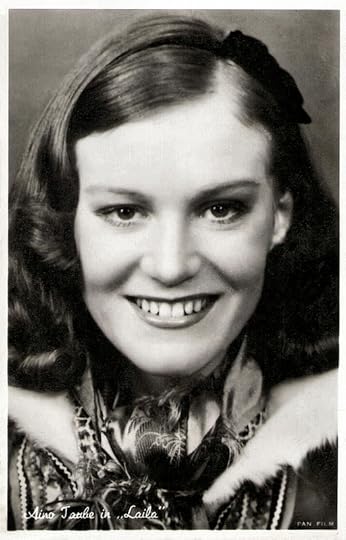
Dutch postcard by M. Bonnist & Zonen, Amsterdam, Z., no. 1225. Photo: Fan Film. Publicity still for Laila (George Schnéevoigt, 1937).
Orphan
Aino Taube was born in Espergærde, Denmark, in 1912. She was the daughter of actor Mattias Taube.
She was trained at the Dramatens elevskola, the drama school in Stockholm, from 1930 till 1932, and she would later also teach there from 1955 till 1988.
In 1931 she made her film debut in the comedy Skepparkärlek/Ship of Love (Ivar Johansson, 1931).
In the 1930s and 1940s she would appear in 28 films, including Sången om den eldröda blomman/Man's Way with Women (Per-Axel Branner, 1934), Familjen som var en karusell/The Family That Was a Carousel (Schamyl Bauman, 1936), and Sara lär sig folkvett/Sara Learns Manners (Gustaf Molander, 1937).
Her breakthrough was her title role in Laila (George Schneevoigt, 1937). Laila tells the story of Lap herders who rescue a baby from a herd of wolves, name her Laila and their struggles and trials over the years. Aino Taube played the orphan as an adult.
Director George Schneevoigt was praised for the rugged beauty of Lapland. The pictorial beauty of the country - and of Taube - plus the sweeping action shots of wolves attacking the herder's reindeer while moving across the tundra made the film an international success.
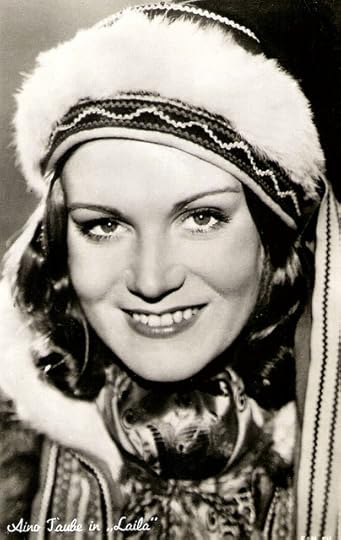
Dutch postcard by M. Bonnist & Zonen, Amsterdam, Z., no. 1224. Photo: Fan Film. Publicity still for Laila (George Schnéevoigt, 1937).
Secrets of Women
In the following years Aino Taube made films like Gubben kommer/Gubben is Coming (Per Lindberg, 1939) with Victor Sjöström, En enda natt/One Single Night (Gustaf Molander, 1939) with Ingrid Bergman , and Med livet som insats/They Staked Their Lives (Thor L. Brooks, Alf Sjöberg, 1940).
From 1950 on, Taube worked for the theatre ensemble of the Swedish television. Between 1954 and 1982 she was also a permanent actress of the Kungliga Dramatiska Teatern (Royal Dramatic Theatre), the national stage of Sweden.
Among her later films were Ingmar Bergman’s Kvinnors väntan/Secrets of Women (1952) with Anita Björk , För min heta ungdoms skull/For the Sake of My Intemperate Youth (Arne Mattsson, 1952), Fadern/The Father (Alf Sjöberg, 1969), and The Touch (Ingmar Bergman, 1971), Bergman's first English-language film.
In the psychological drama Ansikte mot ansikte/Face to Face (Ingmar Bergman, 1976), she played the grandmother who haunts Liv Ullmann's character in her visions.
In 1981 Taube was honored with the O’Neill stipendium, a prestigious Swedish theatre award. Her last film role was in Friends (Kjell-Åke Andersson, 1988) with Stellan Skarsgård and Lena Olin.
Aino Taube died in 1990 in Stockholm. She was married to actor and film director Anders Henrikson, in whose films she often appeared. Their son is actor Mathias Henrikson.
Scene from Ansikte mot ansikte/Face to Face (1976). Source: Lilitesen (YouTube).
Sources: AllMovie, Wikipedia and .

Dutch postcard by M. Bonnist & Zonen, Amsterdam, Z., no. 1225. Photo: Fan Film. Publicity still for Laila (George Schnéevoigt, 1937).
Orphan
Aino Taube was born in Espergærde, Denmark, in 1912. She was the daughter of actor Mattias Taube.
She was trained at the Dramatens elevskola, the drama school in Stockholm, from 1930 till 1932, and she would later also teach there from 1955 till 1988.
In 1931 she made her film debut in the comedy Skepparkärlek/Ship of Love (Ivar Johansson, 1931).
In the 1930s and 1940s she would appear in 28 films, including Sången om den eldröda blomman/Man's Way with Women (Per-Axel Branner, 1934), Familjen som var en karusell/The Family That Was a Carousel (Schamyl Bauman, 1936), and Sara lär sig folkvett/Sara Learns Manners (Gustaf Molander, 1937).
Her breakthrough was her title role in Laila (George Schneevoigt, 1937). Laila tells the story of Lap herders who rescue a baby from a herd of wolves, name her Laila and their struggles and trials over the years. Aino Taube played the orphan as an adult.
Director George Schneevoigt was praised for the rugged beauty of Lapland. The pictorial beauty of the country - and of Taube - plus the sweeping action shots of wolves attacking the herder's reindeer while moving across the tundra made the film an international success.

Dutch postcard by M. Bonnist & Zonen, Amsterdam, Z., no. 1224. Photo: Fan Film. Publicity still for Laila (George Schnéevoigt, 1937).
Secrets of Women
In the following years Aino Taube made films like Gubben kommer/Gubben is Coming (Per Lindberg, 1939) with Victor Sjöström, En enda natt/One Single Night (Gustaf Molander, 1939) with Ingrid Bergman , and Med livet som insats/They Staked Their Lives (Thor L. Brooks, Alf Sjöberg, 1940).
From 1950 on, Taube worked for the theatre ensemble of the Swedish television. Between 1954 and 1982 she was also a permanent actress of the Kungliga Dramatiska Teatern (Royal Dramatic Theatre), the national stage of Sweden.
Among her later films were Ingmar Bergman’s Kvinnors väntan/Secrets of Women (1952) with Anita Björk , För min heta ungdoms skull/For the Sake of My Intemperate Youth (Arne Mattsson, 1952), Fadern/The Father (Alf Sjöberg, 1969), and The Touch (Ingmar Bergman, 1971), Bergman's first English-language film.
In the psychological drama Ansikte mot ansikte/Face to Face (Ingmar Bergman, 1976), she played the grandmother who haunts Liv Ullmann's character in her visions.
In 1981 Taube was honored with the O’Neill stipendium, a prestigious Swedish theatre award. Her last film role was in Friends (Kjell-Åke Andersson, 1988) with Stellan Skarsgård and Lena Olin.
Aino Taube died in 1990 in Stockholm. She was married to actor and film director Anders Henrikson, in whose films she often appeared. Their son is actor Mathias Henrikson.
Scene from Ansikte mot ansikte/Face to Face (1976). Source: Lilitesen (YouTube).
Sources: AllMovie, Wikipedia and .
Published on December 17, 2013 23:00
December 16, 2013
Gillian Hills
In the 1960s, beautiful blonde British starlet Gillian Hills (1944) rose to fame in France, where she a was a successful yé-yé singer and debuted in Roger Vadim’s Les Liaisons dangereuses (1959). In Great Britain she played the title role in the cult film Beat Girl (1960) and also appeared in classics like Blowup (1966) and Clockwork Orange (1971).
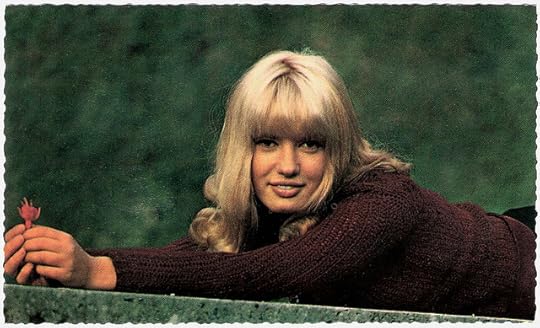
French postcard by Publistar, Marseille, offered by Corvisart, no. 1125. Photo: Patrick Bertrand.
Teen Terror
Gillian Hills was born in Cairo, Egypt in 1944. Her parents were author and adventurer Denis Hills and Dunia Leśmian, daughter of Polish symbolist poet Bolesław Leśmian. She spent her early years in France.
Only 14, she was discovered by Roger Vadim. He saw her as the new Brigitte Bardot and cast her in his Les Liaisons dangereuses//Dangerous Liaisons 1960 (Roger Vadim, 1959), starring Jeanne Moreau and Gérard Philipe . Vadim updated the 1892 novel by Pierre Choderlos de Laclos to a late-1950s French bourgeois milieu. Her small part prompted an appearance on the cover of Paris Match magazine.
In Great Britain, she played teen terror Jennifer Linden in the juvenile delinquent film Beat Girl (Edmond T. Gréville, 1960), a cult classic about the London beatnik scene. Among her co-stars were David Farrar, Christopher Lee, Adam Faith in his first film role and Oliver Reed, with whom Hills danced the hippy-hippy-shake. The soundtrack was composed by John Barry, known for his later James Bond scores.
Bruce Eder at AllMovie does not like the film: “Apart from the rock & roll music that is woven into the action, provided by Adam Faith and the John Barry Seven, and some good location shots around London's Soho circa 1959-1960, there never was much to recommend this unconvincing drama, whose plot, dialogue, and acting all seem totally artificial. Even the so-called ‘beatniks’ were more juvenile delinquents than non-conformists, and had little (if any) resemblance to the real beats (mostly would-be artists and poets) who lived in Soho.
Gillian Hills, who would make a much bigger splash in Blow-Up a little more than a half-decade later, gives a horrendous performance as the troubled teen whose frustration with her family life (which includes a luxurious home with servants) leads her to disaster.”

French postcard by E.D.U.G., no. 312, presented by Corvisart, Epinal. Photo: Sam Lévin .
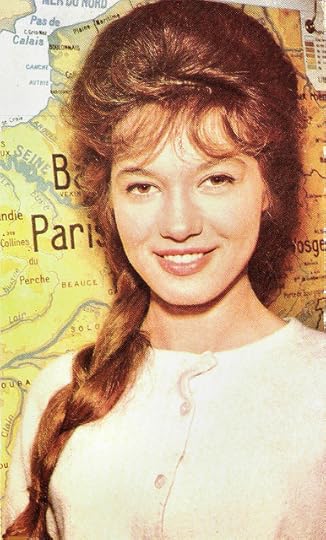
French postcard by Editions P.I., no. 1087, presented by Corvisart, Epinal. Photo: Ektachrome Anders.
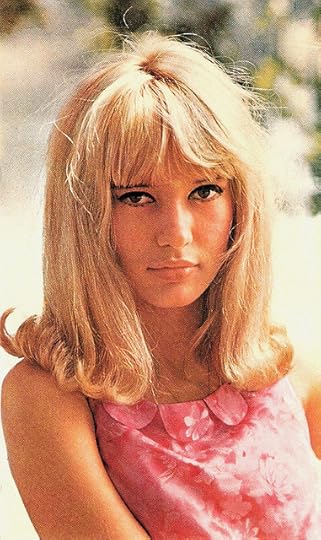
French postcard by PDG, no. 1205, presented by Corvisart, Epinal. Photo: Dalmas / Disc AZ.
Yé-Yé Girl
Gillian Hills then signed with the Paris-based Barclay Records label and released her first EP entitled Allo Brigitte..ne coupez pas! (1960). The song Cou-couche panier proved the most popular track and became a top ten hit in January 1961.
With Eddie Constantine she recorded the duets Spécialisation and Aimons-nous, both originally Marilyn Monroe songs from the film Let’s make love.
In 1961, the new yé-yé star performed at the prestigious Olympia Theatre in Paris on a bill with Johnny Hallyday .
She also appeared with Catherine Deneuve and Hallyday in a segment of the anthology film Les Parisiennes/Tales of Paris (Marc Allégret, 1962). She released the track C’est bien mieux comme ça from the film, backed by rock group Les Chaussettes Noires . The song gave her another hit, reaching the top 20.
Her next EP included the songs, En dansant le twist – a version of The Shirelles’ Mama said and Helen Shapiro covers, Je reviens vers le bonheur (Walkin’ back to happiness) and Mon cœur est prêt (Don’t treat me like a child).
Yé-yé girls were all the rage, and Gillian’s next release, Tu mens, was a slab of Sylvie Vartan -styled yé-yé. One of the chief differences between the two singers, however, was that Gillian had begun writing most of her songs herself, but the EP was not a commercial success.
In Germany she played a white jungle goddess opposite Pierre Brice in the adventure film Die goldene Göttin vom Rio Beni/Golden Goddess of Rio Beni (Franz Eichhorn, Eugenio Martín, 1964).
She appeared on French TV screen with Serge Gainsbourg, performing Une tasse d’anxiété, although the pair never issued the song on vinyl.
In 1965, she signed to the AZ record label and issued an EP which included a cover of the Zombies Leave Me Be and her self-written Rien n’est changé (1965). Sadly, it proved to be her last French release.
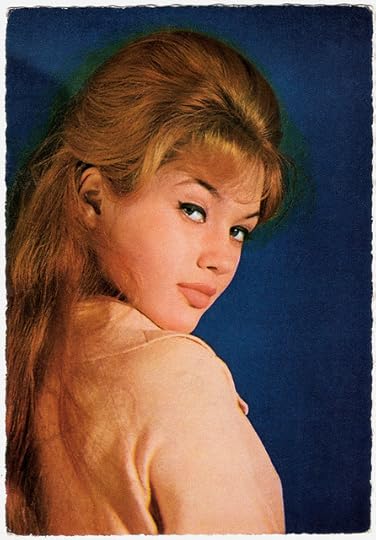
French postcard by E.D.U.G., no. 292. Photo: Roland Carre / Barclay.

German postcard by Krüger, no. 902/204. Photo: Pierre Spitzer.
The Brunette
At the close of her recording career, Gillian Hills returned to England and to the cinema. She appeared as a Brunette in Michelangelo Antonioni's first English language film, the classic Blowup (1966), starring David Hemmings as a fashion photographer. With Hemmings and Jane Birkin (credited as The Blonde!), Hills shared a brief, energetic scene in which all their clothes were gradually removed. Blowup won the Grand Prix at the Cannes Film Festival and was nominated for several other awards.
Next Hills played in Inadmissible Evidence (Anthony Page, 1968), based on the play by John Osborne, and in the mystery romance Three (James Salter, 1969) starring Charlotte Rampling.
On TV, she starred in the classic eight-part series The Owl Service (Peter Plummer, 1969) adapted of Alan Garner's fantasy novel.
In France she was seen with Francis Huster in La faute de l'abbé Mouret/The Sin of Father Mouret (Georges Franju 1970), based on a novel by Émile Zola, and with Anna Gaël in a Swedish-French film version of Zola’s Nana (Mac Ahlberg, 1970).
Hills also did a cameo in A Clockwork Orange (Stanley Kubrick, 1971) as one of the two girls picked up by Alex (Malcolm McDowell) in a record shop. She then appeared in the Hammer horror film Demons of the Mind (Peter Sykes, 1972).
In Spain, she made the thriller La muerte llama a las 10/The Killer Wore Gloves (Juan Bosch, 1974) and the Western Dallas (Juan Bosch, 1975) with Anthony Steffen .
In 1975, Hills decided to stop making films and moved to New York to work as an illustrator for books and magazines.
Gillian Hills is married to Stewart Young, the manager for such artists as AC/DC, Emerson, Lake & Palmer, Cyndi Lauper, and Zucchero. She now lives in England.
Clip of Zou bisou bisou (1962). Source: MrNonosse1 (YouTube).
Gillian Hills sings Rien n’est changé (1965). Source: noma35 (YouTube).
Sources: Bruce Eder (AllMovie), Paul Gallagher (Dangerous Minds), Ready Steady Girls!, GillianHills.com, Wikipedia and .

French postcard by Publistar, Marseille, offered by Corvisart, no. 1125. Photo: Patrick Bertrand.
Teen Terror
Gillian Hills was born in Cairo, Egypt in 1944. Her parents were author and adventurer Denis Hills and Dunia Leśmian, daughter of Polish symbolist poet Bolesław Leśmian. She spent her early years in France.
Only 14, she was discovered by Roger Vadim. He saw her as the new Brigitte Bardot and cast her in his Les Liaisons dangereuses//Dangerous Liaisons 1960 (Roger Vadim, 1959), starring Jeanne Moreau and Gérard Philipe . Vadim updated the 1892 novel by Pierre Choderlos de Laclos to a late-1950s French bourgeois milieu. Her small part prompted an appearance on the cover of Paris Match magazine.
In Great Britain, she played teen terror Jennifer Linden in the juvenile delinquent film Beat Girl (Edmond T. Gréville, 1960), a cult classic about the London beatnik scene. Among her co-stars were David Farrar, Christopher Lee, Adam Faith in his first film role and Oliver Reed, with whom Hills danced the hippy-hippy-shake. The soundtrack was composed by John Barry, known for his later James Bond scores.
Bruce Eder at AllMovie does not like the film: “Apart from the rock & roll music that is woven into the action, provided by Adam Faith and the John Barry Seven, and some good location shots around London's Soho circa 1959-1960, there never was much to recommend this unconvincing drama, whose plot, dialogue, and acting all seem totally artificial. Even the so-called ‘beatniks’ were more juvenile delinquents than non-conformists, and had little (if any) resemblance to the real beats (mostly would-be artists and poets) who lived in Soho.
Gillian Hills, who would make a much bigger splash in Blow-Up a little more than a half-decade later, gives a horrendous performance as the troubled teen whose frustration with her family life (which includes a luxurious home with servants) leads her to disaster.”

French postcard by E.D.U.G., no. 312, presented by Corvisart, Epinal. Photo: Sam Lévin .

French postcard by Editions P.I., no. 1087, presented by Corvisart, Epinal. Photo: Ektachrome Anders.

French postcard by PDG, no. 1205, presented by Corvisart, Epinal. Photo: Dalmas / Disc AZ.
Yé-Yé Girl
Gillian Hills then signed with the Paris-based Barclay Records label and released her first EP entitled Allo Brigitte..ne coupez pas! (1960). The song Cou-couche panier proved the most popular track and became a top ten hit in January 1961.
With Eddie Constantine she recorded the duets Spécialisation and Aimons-nous, both originally Marilyn Monroe songs from the film Let’s make love.
In 1961, the new yé-yé star performed at the prestigious Olympia Theatre in Paris on a bill with Johnny Hallyday .
She also appeared with Catherine Deneuve and Hallyday in a segment of the anthology film Les Parisiennes/Tales of Paris (Marc Allégret, 1962). She released the track C’est bien mieux comme ça from the film, backed by rock group Les Chaussettes Noires . The song gave her another hit, reaching the top 20.
Her next EP included the songs, En dansant le twist – a version of The Shirelles’ Mama said and Helen Shapiro covers, Je reviens vers le bonheur (Walkin’ back to happiness) and Mon cœur est prêt (Don’t treat me like a child).
Yé-yé girls were all the rage, and Gillian’s next release, Tu mens, was a slab of Sylvie Vartan -styled yé-yé. One of the chief differences between the two singers, however, was that Gillian had begun writing most of her songs herself, but the EP was not a commercial success.
In Germany she played a white jungle goddess opposite Pierre Brice in the adventure film Die goldene Göttin vom Rio Beni/Golden Goddess of Rio Beni (Franz Eichhorn, Eugenio Martín, 1964).
She appeared on French TV screen with Serge Gainsbourg, performing Une tasse d’anxiété, although the pair never issued the song on vinyl.
In 1965, she signed to the AZ record label and issued an EP which included a cover of the Zombies Leave Me Be and her self-written Rien n’est changé (1965). Sadly, it proved to be her last French release.

French postcard by E.D.U.G., no. 292. Photo: Roland Carre / Barclay.

German postcard by Krüger, no. 902/204. Photo: Pierre Spitzer.
The Brunette
At the close of her recording career, Gillian Hills returned to England and to the cinema. She appeared as a Brunette in Michelangelo Antonioni's first English language film, the classic Blowup (1966), starring David Hemmings as a fashion photographer. With Hemmings and Jane Birkin (credited as The Blonde!), Hills shared a brief, energetic scene in which all their clothes were gradually removed. Blowup won the Grand Prix at the Cannes Film Festival and was nominated for several other awards.
Next Hills played in Inadmissible Evidence (Anthony Page, 1968), based on the play by John Osborne, and in the mystery romance Three (James Salter, 1969) starring Charlotte Rampling.
On TV, she starred in the classic eight-part series The Owl Service (Peter Plummer, 1969) adapted of Alan Garner's fantasy novel.
In France she was seen with Francis Huster in La faute de l'abbé Mouret/The Sin of Father Mouret (Georges Franju 1970), based on a novel by Émile Zola, and with Anna Gaël in a Swedish-French film version of Zola’s Nana (Mac Ahlberg, 1970).
Hills also did a cameo in A Clockwork Orange (Stanley Kubrick, 1971) as one of the two girls picked up by Alex (Malcolm McDowell) in a record shop. She then appeared in the Hammer horror film Demons of the Mind (Peter Sykes, 1972).
In Spain, she made the thriller La muerte llama a las 10/The Killer Wore Gloves (Juan Bosch, 1974) and the Western Dallas (Juan Bosch, 1975) with Anthony Steffen .
In 1975, Hills decided to stop making films and moved to New York to work as an illustrator for books and magazines.
Gillian Hills is married to Stewart Young, the manager for such artists as AC/DC, Emerson, Lake & Palmer, Cyndi Lauper, and Zucchero. She now lives in England.
Clip of Zou bisou bisou (1962). Source: MrNonosse1 (YouTube).
Gillian Hills sings Rien n’est changé (1965). Source: noma35 (YouTube).
Sources: Bruce Eder (AllMovie), Paul Gallagher (Dangerous Minds), Ready Steady Girls!, GillianHills.com, Wikipedia and .
Published on December 16, 2013 23:00
December 15, 2013
Winfried Glatzeder
Tall and lean Winfried Glatzeder (1945) was one of the most popular film stars of former East Germany. He played the charming, gawky Paul in the GDR cult-film Die Legende von Paul und Paula/The Legend of Paul and Paula (1973).
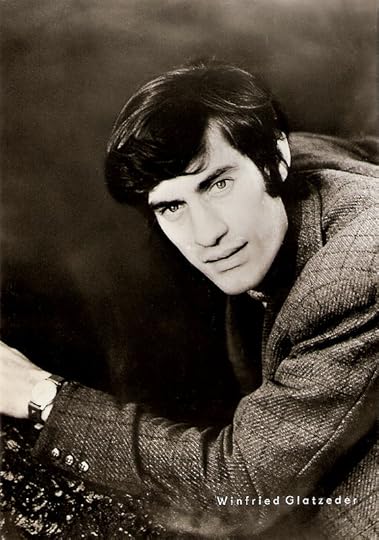
East-German postcard by VEB Progress Filmvertrieb, Berlin, no. 74/71, 1971. Retail price: 0,20 M. Photo: Linke.
Bold Boxer’s Nose, Bright Eyes and Black Hair
Winfried Glatzeder was born in Zoppot, Germany (now Sopot, Poland) in 1945. His father was a doctor, who died in a Soviet camp for prisoners of war, his mother was a social welfare worker.
During his training as a mechanical engineer, Winfried launched a cabaret group. He worked as a mechanical engineer before he went to study at the Hochschule für Film und Fernsehen Potsdam-Babelsberg (School of Television and Film in Potsdam) in 1965. In 1969, he graduated with a thesis on the figure of the clown.
He had started his cinema career as an extra in Ein Lord am Alexanderplatz/Lord of Alexander Square (Günter Reisch, 1967). The stars of this DEFA comedy were Erwin Geschonneck, Angelica Domröse and Armin Mueller-Stahl .
Several more bit roles followed, but in 1970 he had his first leading part as an oil worker in the romantic drama Zeit der Störche/Time of the Storks (Siegfried Kühn, 1971) opposite Heidemarie Wenzel.
Female critics liked his bold boxer’s nose, bright eyes and black hair. He then had supporting parts in the comedy Der Mann, der nach der Oma kam/The man who came to the grandmother (Roland Oehme, 1972) as a surrogate grandmother, and in the comedy-drama Das zweite Leben des Friedrich Wilhelm Georg Platow/The Second Life of F.W.G. Platow (Siegfried Kühn, 1973) featuring Fritz Marquardt.
With his role as Paul opposite Angelica Domröse as Paula in Die Legende von Paul und Paula/The Legend of Paul and Paula (Heiner Carow, 1973), he gained enormous popularity in East Germany. The film gives a realistic view of everyday life in East Berlin during the 1970s. It's mainly about the bitter-sweet romance of Paul, a privileged but unhappy secret service agent, and Paula, an underprivileged and single girl with children.
The film was extremely popular on release and had drawn 3,294,985 viewers. However, due to the film's political overtones it was almost not released; East German leader Erich Honecker personally decided to allow it to be shown. Die Legende von Paul und Paula is still so popular that the city of Berlin decided to name a path along the lake Rummelsburger See ‘the Paul und Paula Ufer’ (Paul And Paula Shore) with a Paul and Paula bench to sit on.
Glatzeder then starred in the historic comedy Till Eulenspiegel (Rainer Simon, 1975) with Cox Habbema , Nelken in Aspik (Günter Reisch, 1976) with Armin Mueller-Stahl , and the crime film Für Mord kein Beweis/No evidence for murder (Konrad Petzold, 1979).
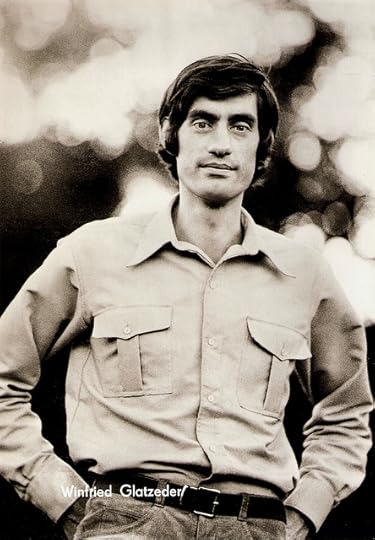
Big East-German postcard by VEB Progress Filmvertrieb, Berlin, no. 163/73, 1971. Retail price: 0,50 M. Photo: Linke.
From East To West
Although he was one of East Germany's most popular actors, Winfried Glatzeder and his family left the country and emigrated to West Germany in 1982. There he was engaged at the Schillertheater and worked for television.
In the cinema he was seen in the slapstick comedy Didi - Der Doppelgänger/Non-Stop Trouble with My Double (Reinhard Schwabenitzky, 1984) starring comedian Dieter Hallervorden, and the action adventure Danger - Keine Zeit zum Sterben/No Time to Die (Helmut Ashley, 1984) with John Philip Law.
Then he played Antonio Salieri in Vergeßt Mozart/Forget Mozart (Miloslav Luther, 1985) with Armin Mueller-Stahl . The film was nominated for a Golden Lion at the Venice Film Festival.
He had a supporting part in Rosa Luxemburg (Margaretha von Trotta, 1986) featuring Barbara Sukowa. In 1991 he worked again for the DEFA on Tanz auf der Kippe/Dancing at the Dump (Jürgen Brauer, 1991). He also played a closeted gay man falling in love with a young boy in Gossenkind/Street Kid (Peter Kern, 1992).
Interesting was the DEFA production Das Land hinter dem Regenbogen/The Land Beyond the Rainbow (Herwig Kipping, 1992), a harsh yet poetic critique of Stalinism in East Germany. He became well known on TV as Hauptkommissar (chief commissioner) Ernst Roiter in the Krimi series Tatort (1996–1998).
Later films include Die kaukasische Nacht/The Caucasian Night (Gordian Maugg, 1998) and the box office hit Sonnenallee/Sun Alley (Leander Haußmann, 1999), a comedy about life in East Berlin in the late 1970s. Glatzeder makes a brief cameo appearance, reprising his role as Paul from Die Legende von Paul und Paula (1973).
In the meanwhile he also appeared on stage. In 2006 he played the villain Santer at the Karl-May-Festspielen in Bad Segeberg. A year later, he reunited with Angelica Domröse for the play Filumena at the Hans Otto Theater in Potsdam. His most recent film is Die Lebenden/The Dead and the Living (Barbara Albert, 2012).
Since 1970, Winfried Glatzeder is married to Marion Glatzeder and they have two children, Philip (1975) and actor Robert Glatzeder (1971 or 1972) who had made his film debut as Paul’s son in Die Legende von Paul und Paula (1973). Winfried Glatzeder lives in Berlin.
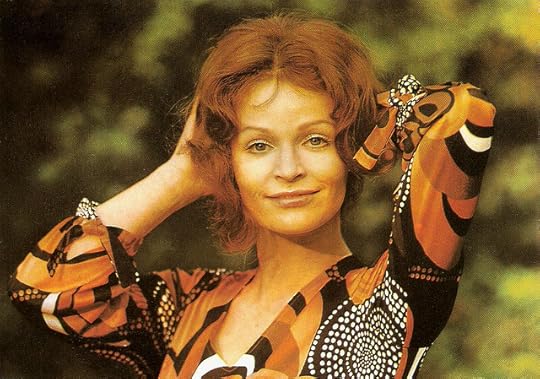
Angelica Domröse . East-German postcard by VEB Progress Film-Vertrieb, Berlin, no. 4/F/73, 1973. Retail price: 0,20 MDN. Photo: Linke.
Trailer Die Legende von Paul und Paula/The Legend of Paul and Paula (1973). Source: Defastift (YouTube).
Sources: Ines Walk (Filmzeit.de), Filmportal.de, Prisma (German), Wikipedia (German and English), and IMDb.

East-German postcard by VEB Progress Filmvertrieb, Berlin, no. 74/71, 1971. Retail price: 0,20 M. Photo: Linke.
Bold Boxer’s Nose, Bright Eyes and Black Hair
Winfried Glatzeder was born in Zoppot, Germany (now Sopot, Poland) in 1945. His father was a doctor, who died in a Soviet camp for prisoners of war, his mother was a social welfare worker.
During his training as a mechanical engineer, Winfried launched a cabaret group. He worked as a mechanical engineer before he went to study at the Hochschule für Film und Fernsehen Potsdam-Babelsberg (School of Television and Film in Potsdam) in 1965. In 1969, he graduated with a thesis on the figure of the clown.
He had started his cinema career as an extra in Ein Lord am Alexanderplatz/Lord of Alexander Square (Günter Reisch, 1967). The stars of this DEFA comedy were Erwin Geschonneck, Angelica Domröse and Armin Mueller-Stahl .
Several more bit roles followed, but in 1970 he had his first leading part as an oil worker in the romantic drama Zeit der Störche/Time of the Storks (Siegfried Kühn, 1971) opposite Heidemarie Wenzel.
Female critics liked his bold boxer’s nose, bright eyes and black hair. He then had supporting parts in the comedy Der Mann, der nach der Oma kam/The man who came to the grandmother (Roland Oehme, 1972) as a surrogate grandmother, and in the comedy-drama Das zweite Leben des Friedrich Wilhelm Georg Platow/The Second Life of F.W.G. Platow (Siegfried Kühn, 1973) featuring Fritz Marquardt.
With his role as Paul opposite Angelica Domröse as Paula in Die Legende von Paul und Paula/The Legend of Paul and Paula (Heiner Carow, 1973), he gained enormous popularity in East Germany. The film gives a realistic view of everyday life in East Berlin during the 1970s. It's mainly about the bitter-sweet romance of Paul, a privileged but unhappy secret service agent, and Paula, an underprivileged and single girl with children.
The film was extremely popular on release and had drawn 3,294,985 viewers. However, due to the film's political overtones it was almost not released; East German leader Erich Honecker personally decided to allow it to be shown. Die Legende von Paul und Paula is still so popular that the city of Berlin decided to name a path along the lake Rummelsburger See ‘the Paul und Paula Ufer’ (Paul And Paula Shore) with a Paul and Paula bench to sit on.
Glatzeder then starred in the historic comedy Till Eulenspiegel (Rainer Simon, 1975) with Cox Habbema , Nelken in Aspik (Günter Reisch, 1976) with Armin Mueller-Stahl , and the crime film Für Mord kein Beweis/No evidence for murder (Konrad Petzold, 1979).

Big East-German postcard by VEB Progress Filmvertrieb, Berlin, no. 163/73, 1971. Retail price: 0,50 M. Photo: Linke.
From East To West
Although he was one of East Germany's most popular actors, Winfried Glatzeder and his family left the country and emigrated to West Germany in 1982. There he was engaged at the Schillertheater and worked for television.
In the cinema he was seen in the slapstick comedy Didi - Der Doppelgänger/Non-Stop Trouble with My Double (Reinhard Schwabenitzky, 1984) starring comedian Dieter Hallervorden, and the action adventure Danger - Keine Zeit zum Sterben/No Time to Die (Helmut Ashley, 1984) with John Philip Law.
Then he played Antonio Salieri in Vergeßt Mozart/Forget Mozart (Miloslav Luther, 1985) with Armin Mueller-Stahl . The film was nominated for a Golden Lion at the Venice Film Festival.
He had a supporting part in Rosa Luxemburg (Margaretha von Trotta, 1986) featuring Barbara Sukowa. In 1991 he worked again for the DEFA on Tanz auf der Kippe/Dancing at the Dump (Jürgen Brauer, 1991). He also played a closeted gay man falling in love with a young boy in Gossenkind/Street Kid (Peter Kern, 1992).
Interesting was the DEFA production Das Land hinter dem Regenbogen/The Land Beyond the Rainbow (Herwig Kipping, 1992), a harsh yet poetic critique of Stalinism in East Germany. He became well known on TV as Hauptkommissar (chief commissioner) Ernst Roiter in the Krimi series Tatort (1996–1998).
Later films include Die kaukasische Nacht/The Caucasian Night (Gordian Maugg, 1998) and the box office hit Sonnenallee/Sun Alley (Leander Haußmann, 1999), a comedy about life in East Berlin in the late 1970s. Glatzeder makes a brief cameo appearance, reprising his role as Paul from Die Legende von Paul und Paula (1973).
In the meanwhile he also appeared on stage. In 2006 he played the villain Santer at the Karl-May-Festspielen in Bad Segeberg. A year later, he reunited with Angelica Domröse for the play Filumena at the Hans Otto Theater in Potsdam. His most recent film is Die Lebenden/The Dead and the Living (Barbara Albert, 2012).
Since 1970, Winfried Glatzeder is married to Marion Glatzeder and they have two children, Philip (1975) and actor Robert Glatzeder (1971 or 1972) who had made his film debut as Paul’s son in Die Legende von Paul und Paula (1973). Winfried Glatzeder lives in Berlin.

Angelica Domröse . East-German postcard by VEB Progress Film-Vertrieb, Berlin, no. 4/F/73, 1973. Retail price: 0,20 MDN. Photo: Linke.
Trailer Die Legende von Paul und Paula/The Legend of Paul and Paula (1973). Source: Defastift (YouTube).
Sources: Ines Walk (Filmzeit.de), Filmportal.de, Prisma (German), Wikipedia (German and English), and IMDb.
Published on December 15, 2013 23:00
Peter O'Toole (1932-2013)
British actor Peter O'Toole died on Saturday 14 December. The golden-haired, blue-eyed film actor became an international superstar with his unforgettable turn as the British expatriate T.E. Lawrence in David Lean's epic masterpiece Lawrence of Arabia (1962). After surviving cancer and alcoholism, O’Toole made a triumphant come-back with Oscar nominated appearances in The Stunt Man (1980) and My Favorite Year (1982). He was 81.
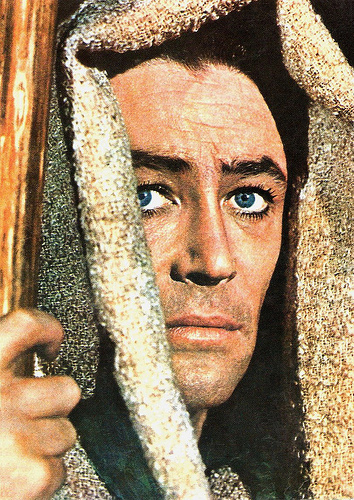
Romanian postcard by Casa Filmului Acin.
Intensity and Zeal
Peter Seamus Lorcan O'Toole was born in 1932. According to IMDb , he was born in Connemara, Ireland. Others sources indicate Leeds, England, where he also grew up, as his birthplace. In his autobiography Loitering with Intent: the Child (1992), O’Toole writes that he is not certain of his birthplace, while he has birth certificates from two countries.
However, he was the son of Constance Jane (née Ferguson), a Scottish nurse, and Patrick Joseph O'Toole, an Irish metal platter, football player and racecourse bookmaker. As a boy, Peter decided to become a journalist, beginning as a newspaper copy boy.
Although he succeeded in becoming a reporter, he discovered the theatre and made his stage debut at 17. He served as a radioman in the Royal Navy for two years.
From 1952 to 1954 he attended the Royal Academy of Dramatic Art as a scholarship student. His classmates included Albert Finney , Alan Bates and Richard Harris. While at RADA he was active in protesting the British involvement in the Korean War. Later in the 1960’s he would be an active opponent of the Vietnam War.
O'Toole began working in the theatre, gaining recognition as a Shakespearean actor at the Bristol Old Vic and with the English Stage Company, before making an inconspicuous film debut in the Walt Disney production Kidnapped (Robert Stevenson, 1960), a faithful adaptation of the Robert Louis Stevenson classic.
Two years later, O'Toole was chosen by director David Lean to play Thomas E. Lawrence in Lawrence of Arabia (David Lean, 1962). The part of the conflicted British liaison officer caught at the centre of an Arab revolt made O'Toole an international superstar.
Brian McFarlane observes in the encyclopaedia of British Film : “It was a remarkable study in obsession, catching the right balance between mystic and man of action, bringing to the role kinds of intensity and zeal that few other British actors could have done”.
O' Toole continued successfully in artistically rich films as well as less artistic but commercially rewarding projects. He was nominated as Best Actor for King Henry II in Becket (Peter Glenville, 1964) starring Richard Burton . Two years later he was nominated again for portraying Henry II, this time in The Lion in Winter (Anthony Harvey, 1968) alongside Katharine Hepburn.
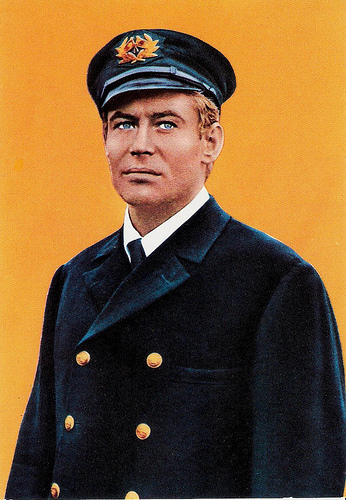
Italian postcard by Rotalfoto, Milano (Milan), no. 278.
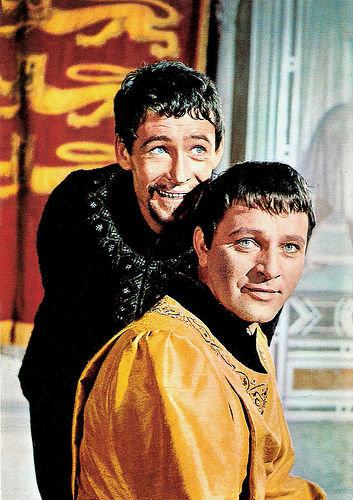
Spanish postcard by Postal Oscarcolor, no. 279. Photo: Publicity shot for Becket (Peter Glenville, 1964) with Richard Burton .
One of Hollywood's Most Infamous Party Animals
Peter O‘Toole is one of the greatest actors of his generation. During his career, he received eight Academy Award nominations but never won the Oscar. (He has more nominations without winning than any other actor.)
TCM suggests that his flamboyant personal life was maybe to blame: “Known as one of Hollywood's most infamous party animals in his prime, O'Toole earned a reputation as a prodigious drinker alongside his contemporaries and fellow countrymen Richard Harris, Richard Burton , and Oliver Reed.
O'Toole's booze-fueled hijinks eventually took their toll, however, on both his career and his health. While the actor did manage to pick up his fifth Oscar nomination for the wickedly funny The Ruling Class (Peter Medak, 1972), the seventies were a low-point in the actor's personal life and career.”
Once considered one of the most beautiful men ever to grace the silver screen only a decade earlier, O'Toole's alcoholism had cost him his looks. In 1979, his 20-year marriage to Irish actress Siân Phillips ended in divorce, when she left him for a younger man.
Medical problems threatened to destroy his life. Originally he thought the problems were the result of his drinking but it turned out to be stomach cancer. He survived by giving up alcohol and by serious medical treatment.
He returned to the cinema with two triumphant performances: a sadistic, tyrannical director in the behind-the-scenes comedy The Stunt Man (Richard Rush, 1980), and an ageing swashbuckling film star strongly resembling Errol Flynn in My Favorite Year (Richard Benjamin, 1982). For both films he received an Oscar nomination.
On stage, he received good reviews as John Tanner in Man and Superman and as Henry Higgins in Pygmalion (1984), and he won a Laurence Olivier Award for his performance in Jeffrey Bernard is Unwell (1989).
However, O'Toole found meaningful film roles increasingly difficult to come by. He appeared in such duds as Supergirl (Jeannot Swarc, 1984), Creator (Ivan Passer, 1985) and Club Paradise (Harold Ramis, 1986), but fortunately he also appeared in the much-garlanded grand epic The Last Emperor (Bernardo Bertolucci, 1987). The film about the final Emperor of China (John Lone) won the Oscar for Best Picture.
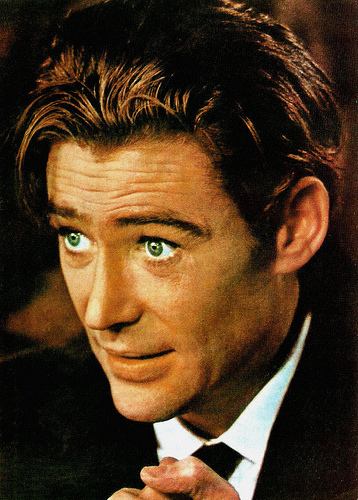
Romanian postcard by Casa Filmului Acin, nr. 384.
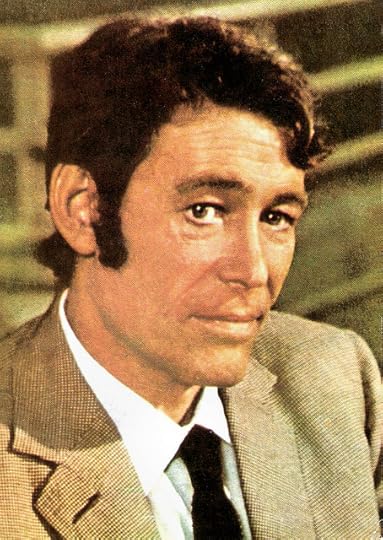
Romanian postcard by Casa Filmului Acin, no. 593.
Still in the Game
After another series of lesser films, Peter O'Toole made again a come-back in the new decennium. In 1999 he won an Emmy Award for his role in the mini-series Joan of Arc (Christian Duguay, 1999).
In 2003, he received a Special Oscar for lifetime achievement, an honour O'Toole only reluctantly accepted. He wrote the Academy a letter stating that he was “still in the game” and proved to be so in the following years.
In the blockbuster Troy (Wolfgang Petersen, 2004) he played the dying King Priam opposite Brad Pitt. In the BBC drama serial Casanova (2005), he appeared as the older version of legendary 18th century Italian adventurer.
He was once again nominated for the Best Actor Academy Award for his portrayal of Maurice in the May-December romantic comedy Venus (Roger Michell, 2006), scripted by Hanif Kureishi. It was his eighth nomination.
O'Toole co-starred as the voice of food critic Anton Ego in the Pixar box office hit Ratatouille (Brad Bird, Jan Pinkava, 2007), an animated film about a rat with dreams of becoming the greatest chef in Paris.
O'Toole appeared in the second season of Showtime's hit drama series The Tudors (2008), portraying Pope Paul III, who excommunicates King Henry VIII (Jonathan Rhys Meyers) from the church. This act leads to a showdown between the two men in seven of the ten episodes.
O'Toole narrated the horror comedy Eldorado (Richard Driscoll, 2011), but last year O'Toole released a statement that he was retiring from acting.
Following a long illness, Peter O'Toole died peacefully in a London hospital on Saturday 14 December 2013, his agent Steve Kenis announced today.
He had two daughters, actresses Patricia O'Toole and Kate O'Toole (1960), from his marriage to Siân Phillips. He also has a son, actor Lorcan O'Toole (1983), by American model Karen Brown. For his body of work he has won four Golden Globes, a BAFTA, and an Emmy.
Trailer Lawrence of Arabia (1962). Source: Ageless Trailers (YouTube).
Trailer of The Last Emperor (1987). Source: Starscream83inc (YouTube).
Trailer of Venus (2006). Source: Fevercity (YouTube).
Sources: Brian McFarlane (Encyclopaedia of British Film), Nathan Southern (AllMovie), (IMDb), TCM, Robert Pardi (Filmreference.com), Wikipedia and .

Romanian postcard by Casa Filmului Acin.
Intensity and Zeal
Peter Seamus Lorcan O'Toole was born in 1932. According to IMDb , he was born in Connemara, Ireland. Others sources indicate Leeds, England, where he also grew up, as his birthplace. In his autobiography Loitering with Intent: the Child (1992), O’Toole writes that he is not certain of his birthplace, while he has birth certificates from two countries.
However, he was the son of Constance Jane (née Ferguson), a Scottish nurse, and Patrick Joseph O'Toole, an Irish metal platter, football player and racecourse bookmaker. As a boy, Peter decided to become a journalist, beginning as a newspaper copy boy.
Although he succeeded in becoming a reporter, he discovered the theatre and made his stage debut at 17. He served as a radioman in the Royal Navy for two years.
From 1952 to 1954 he attended the Royal Academy of Dramatic Art as a scholarship student. His classmates included Albert Finney , Alan Bates and Richard Harris. While at RADA he was active in protesting the British involvement in the Korean War. Later in the 1960’s he would be an active opponent of the Vietnam War.
O'Toole began working in the theatre, gaining recognition as a Shakespearean actor at the Bristol Old Vic and with the English Stage Company, before making an inconspicuous film debut in the Walt Disney production Kidnapped (Robert Stevenson, 1960), a faithful adaptation of the Robert Louis Stevenson classic.
Two years later, O'Toole was chosen by director David Lean to play Thomas E. Lawrence in Lawrence of Arabia (David Lean, 1962). The part of the conflicted British liaison officer caught at the centre of an Arab revolt made O'Toole an international superstar.
Brian McFarlane observes in the encyclopaedia of British Film : “It was a remarkable study in obsession, catching the right balance between mystic and man of action, bringing to the role kinds of intensity and zeal that few other British actors could have done”.
O' Toole continued successfully in artistically rich films as well as less artistic but commercially rewarding projects. He was nominated as Best Actor for King Henry II in Becket (Peter Glenville, 1964) starring Richard Burton . Two years later he was nominated again for portraying Henry II, this time in The Lion in Winter (Anthony Harvey, 1968) alongside Katharine Hepburn.

Italian postcard by Rotalfoto, Milano (Milan), no. 278.

Spanish postcard by Postal Oscarcolor, no. 279. Photo: Publicity shot for Becket (Peter Glenville, 1964) with Richard Burton .
One of Hollywood's Most Infamous Party Animals
Peter O‘Toole is one of the greatest actors of his generation. During his career, he received eight Academy Award nominations but never won the Oscar. (He has more nominations without winning than any other actor.)
TCM suggests that his flamboyant personal life was maybe to blame: “Known as one of Hollywood's most infamous party animals in his prime, O'Toole earned a reputation as a prodigious drinker alongside his contemporaries and fellow countrymen Richard Harris, Richard Burton , and Oliver Reed.
O'Toole's booze-fueled hijinks eventually took their toll, however, on both his career and his health. While the actor did manage to pick up his fifth Oscar nomination for the wickedly funny The Ruling Class (Peter Medak, 1972), the seventies were a low-point in the actor's personal life and career.”
Once considered one of the most beautiful men ever to grace the silver screen only a decade earlier, O'Toole's alcoholism had cost him his looks. In 1979, his 20-year marriage to Irish actress Siân Phillips ended in divorce, when she left him for a younger man.
Medical problems threatened to destroy his life. Originally he thought the problems were the result of his drinking but it turned out to be stomach cancer. He survived by giving up alcohol and by serious medical treatment.
He returned to the cinema with two triumphant performances: a sadistic, tyrannical director in the behind-the-scenes comedy The Stunt Man (Richard Rush, 1980), and an ageing swashbuckling film star strongly resembling Errol Flynn in My Favorite Year (Richard Benjamin, 1982). For both films he received an Oscar nomination.
On stage, he received good reviews as John Tanner in Man and Superman and as Henry Higgins in Pygmalion (1984), and he won a Laurence Olivier Award for his performance in Jeffrey Bernard is Unwell (1989).
However, O'Toole found meaningful film roles increasingly difficult to come by. He appeared in such duds as Supergirl (Jeannot Swarc, 1984), Creator (Ivan Passer, 1985) and Club Paradise (Harold Ramis, 1986), but fortunately he also appeared in the much-garlanded grand epic The Last Emperor (Bernardo Bertolucci, 1987). The film about the final Emperor of China (John Lone) won the Oscar for Best Picture.

Romanian postcard by Casa Filmului Acin, nr. 384.

Romanian postcard by Casa Filmului Acin, no. 593.
Still in the Game
After another series of lesser films, Peter O'Toole made again a come-back in the new decennium. In 1999 he won an Emmy Award for his role in the mini-series Joan of Arc (Christian Duguay, 1999).
In 2003, he received a Special Oscar for lifetime achievement, an honour O'Toole only reluctantly accepted. He wrote the Academy a letter stating that he was “still in the game” and proved to be so in the following years.
In the blockbuster Troy (Wolfgang Petersen, 2004) he played the dying King Priam opposite Brad Pitt. In the BBC drama serial Casanova (2005), he appeared as the older version of legendary 18th century Italian adventurer.
He was once again nominated for the Best Actor Academy Award for his portrayal of Maurice in the May-December romantic comedy Venus (Roger Michell, 2006), scripted by Hanif Kureishi. It was his eighth nomination.
O'Toole co-starred as the voice of food critic Anton Ego in the Pixar box office hit Ratatouille (Brad Bird, Jan Pinkava, 2007), an animated film about a rat with dreams of becoming the greatest chef in Paris.
O'Toole appeared in the second season of Showtime's hit drama series The Tudors (2008), portraying Pope Paul III, who excommunicates King Henry VIII (Jonathan Rhys Meyers) from the church. This act leads to a showdown between the two men in seven of the ten episodes.
O'Toole narrated the horror comedy Eldorado (Richard Driscoll, 2011), but last year O'Toole released a statement that he was retiring from acting.
Following a long illness, Peter O'Toole died peacefully in a London hospital on Saturday 14 December 2013, his agent Steve Kenis announced today.
He had two daughters, actresses Patricia O'Toole and Kate O'Toole (1960), from his marriage to Siân Phillips. He also has a son, actor Lorcan O'Toole (1983), by American model Karen Brown. For his body of work he has won four Golden Globes, a BAFTA, and an Emmy.
Trailer Lawrence of Arabia (1962). Source: Ageless Trailers (YouTube).
Trailer of The Last Emperor (1987). Source: Starscream83inc (YouTube).
Trailer of Venus (2006). Source: Fevercity (YouTube).
Sources: Brian McFarlane (Encyclopaedia of British Film), Nathan Southern (AllMovie), (IMDb), TCM, Robert Pardi (Filmreference.com), Wikipedia and .
Published on December 15, 2013 12:30
December 14, 2013
El Cordobés
In the 1960s, the legendary matador El Cordobés (1936) brought a flamboyant, daring style to the bullring. With $3 million dollar per year in his heyday, he was the most highly paid torero in history. Thanks to his good looks, he also starred in some films.
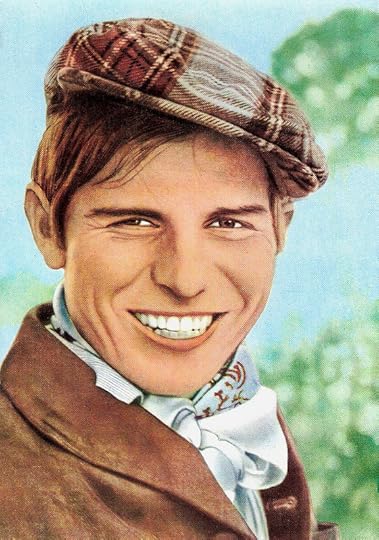
Spanish postcard by A.G.N. Fábregos, no. 70. Photo: Carretero.
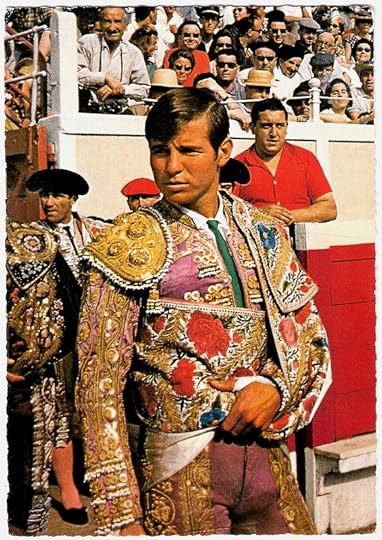
French postcard by Edition Cely / Marcel Pendaries, Saint-Alban, no. 1873. Photo: Aubert Kodaks, Bayonne.
A Classical Tale Of Rags To Riches
The life of Spanish matador El Cordobés (The Man from Cordoba) is a classical tale of rags to riches. As Manuel ‘Manolo’ Benítez Pérez he was born in the slums in Palma del Rio near the city of Cordoba, Andalucía in 1936. At 9, Manolo was an orphan and was reared in an orphanage, where he dreamed of being the greatest bullfighter of Spain. But he was caught by the Guardia Civil stealing chickens and oranges at nearby farms, and was sent to jail for three months.
At 23, he worked as a bricklayer in Madrid and practiced bullfighting on untrained bulls at night. Once he vaulted over the fence at a prestigious bullfight and with an improvised cape began taking a bull through its paces. Officials quickly dragged him away, but it was the start of his bullfighting career.
Promoter Rafael Sánchez, known as ‘El Pipo,’ bought him cows for practice, dreamed up his stage name, helped fashion his gimmicks - and later protected his growing popularity by bribing journalists to overlook his stylistic faults and the invalid bulls he was fighting. During the 1960 season, while he was still a Novillero (novice bullfighter), El Cordobés attracted attention throughout Andalusia. He did not attain full rank as a matador until 1963, when he had already become famous.
El Cordobés’s antics and daredevil stunts - such as kissing the bull between the horns - attracted extraordinary crowds. He made his film debut in the bullfighting drama Aprendiendo a morir/Learning to Die (Pedro Lazaga, 1962). A year later he appeared in the crime drama Chantaje a un torero/The Blackmailers (Rafael Gil, 1963).
One of the original and dangerous ring techniques practiced by El Cordobés was first shown to the world at Anjucar. In stark departure from formality, he waved his Banderillero (Columpio) away, broke his Banderillas down to 'pencil length', and standing with his back to the bull as it charged, moved his right leg out moments before the bull was upon him, causing the bull to swerve and allowing El Cordobés a moment to slam in the Banderillas from just behind the left horn. This maneuver was repeated in bullfights across Spain, sometimes with even more dangerous variations, such as standing with his back to the barerra and driving in the banderillas after the horns passed either side of him.
A significant moment in his career came in 1964, when he made his first appearance at Las Ventas, the bullring of Madrid. Watched on television by many Spaniards, the bullfight ended with the near-fatal goring of El Cordobés on the horns of the bull Impulsivo. Yet twenty-two days later El Cordobés fought again.
The press dubbed him ‘the Beatle of the Bullring’. The crudity of his technique was offset by his exceptional reflexes, courage, and crowd appeal. In 1965 he fought in 111 corridas, breaking the single-season record of 109 established by Juan Belmonte in 1919. At up to $50,000 per bullfight, the poor boy from the slums had become a millionaire.
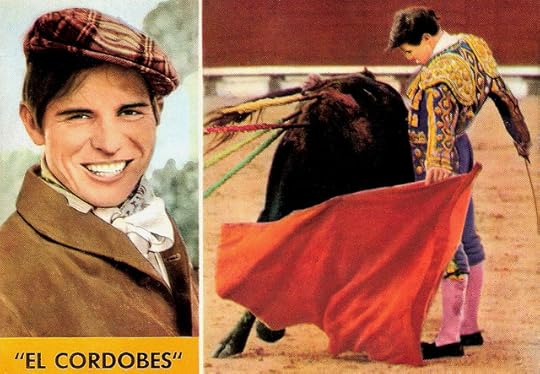
Spanish postcard by A.G.N. Fábregos, no. 60. Photo: Carretero.
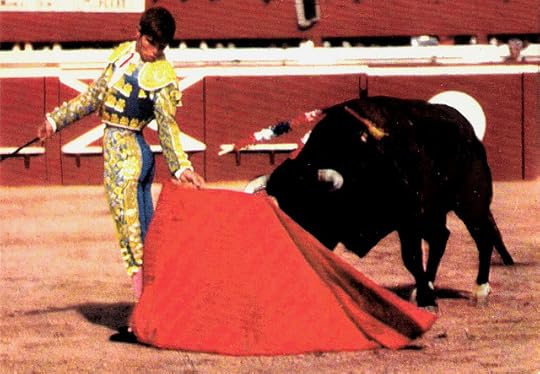
Spanish postcard by Chavir, no. 1.221. Photo: C. Rivas, Barcelona.
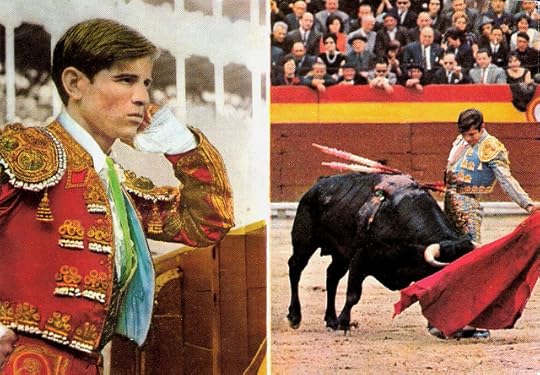
Spanish postcard by A.G.N. Fábregos, no. 70. Photo: Carretero.
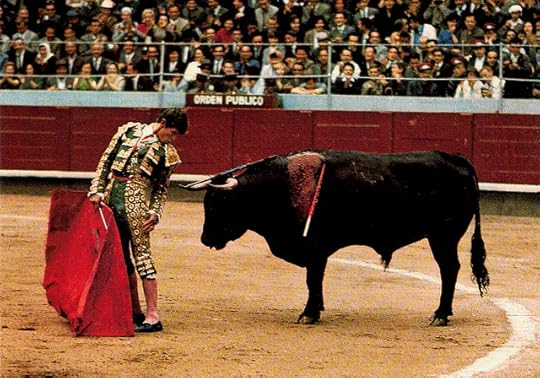
Spanish postcard by CYP Postales Color, Barcelona, no. 5227. Photo: Campana-Puig-Ferran.
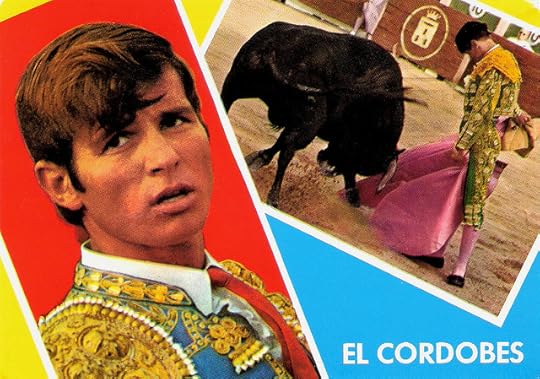
Spanish postcard by Ed. Beascoa, no.517. Photo: Carretero.
Tired Of Raising Pigs
El Cordobés had a cameo in the French film La vie, l'amour, la mort/Life, Love, Death (Claude Lelouch, 1969) and made his fourth film in the Philippines: the comedy Europe Here We Come! (Ben Feleo, 1971). In the meanwhile he squired the world's most beautiful women, owned a Rolls-Royce, flew his own airplane, drove his fans into ecstatic fevers—but in 1972, he suddenly bowed out.
Reportedly battered by the liquor and pills that were fueling his overloaded 100-fight seasons, He married his French girlfriend Martine who had given birth to two of his children - and retired with a vast accumulated fortune in livestock and real estate. He sometimes appeared on TV and was himself in the film Rafael en Raphael (Antonio Isasi-Isasmendi, 1975) about the singer Raphael.
In 1979, after eight years of retirement, the 41-year-old matador returned to bullfighting, ‘tired of raising pigs’. The Spanish critics gave him top marks for his come-back fight. However, most of El Cordobés' engagements were in second-rate rings, where the audiences and the bulls are less demanding.
Following an incident in 1983, when a bull that he was about to fight killed an Espontáneo (‘spontaneous’, a person who illegally jumps into the ring to fight the bull), El Cordobés was much maligned by the press for allowing it to happen. He continued to make occasional appearances as a matador until 2002.
Then after four decades, he retired for good with a bullfight the Las Ventas bullring in Madrid, the sport's most prestigious venue. There he cut off his matador's pigtail, known as a Coleta, ritually ending his bullfighting days.
An early biography, Or I'll Dress You in Mourning by journalists Larry Collins and Dominique Lapierre, was published in 1968 by Simon and Schuster. El Cordobés' story was also the basis for the musical Matador (1987) by Mike Leander and Eddie Seago.
According to legend, Benitez fathered many illegitimate children. For years he refused to acknowledge one son in particular, Manuel Diaz, 34, who also entered the bullfighting scene. A decade ago they reconciled their differences. Today, El Cordobés lives in seclusion near Córdoba.
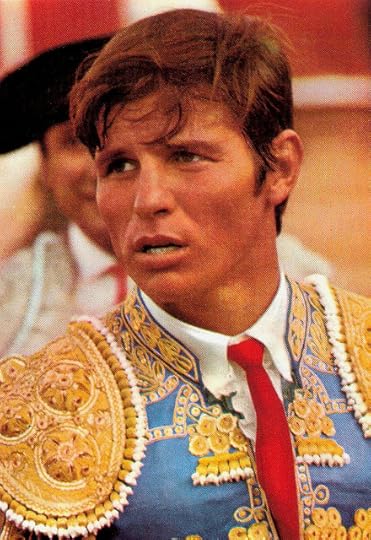
Spanish postcard by A.G.N. Fábregos, no. 92. Sent by mail in 1996. Photo: Carretero.
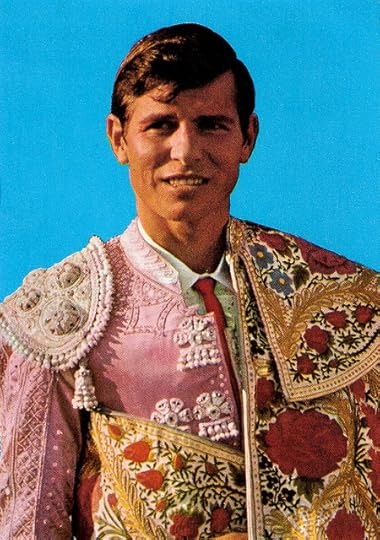
Spanish postcard by A.G.N. Fábregos, no. 87. Photo: Carretero.
Sources: Isambard Wilkinson (The Telegraph), William B. Lyon (People), Encyclopaedia Britannica, Ottawa Citizen, Wikipedia and .

Spanish postcard by A.G.N. Fábregos, no. 70. Photo: Carretero.

French postcard by Edition Cely / Marcel Pendaries, Saint-Alban, no. 1873. Photo: Aubert Kodaks, Bayonne.
A Classical Tale Of Rags To Riches
The life of Spanish matador El Cordobés (The Man from Cordoba) is a classical tale of rags to riches. As Manuel ‘Manolo’ Benítez Pérez he was born in the slums in Palma del Rio near the city of Cordoba, Andalucía in 1936. At 9, Manolo was an orphan and was reared in an orphanage, where he dreamed of being the greatest bullfighter of Spain. But he was caught by the Guardia Civil stealing chickens and oranges at nearby farms, and was sent to jail for three months.
At 23, he worked as a bricklayer in Madrid and practiced bullfighting on untrained bulls at night. Once he vaulted over the fence at a prestigious bullfight and with an improvised cape began taking a bull through its paces. Officials quickly dragged him away, but it was the start of his bullfighting career.
Promoter Rafael Sánchez, known as ‘El Pipo,’ bought him cows for practice, dreamed up his stage name, helped fashion his gimmicks - and later protected his growing popularity by bribing journalists to overlook his stylistic faults and the invalid bulls he was fighting. During the 1960 season, while he was still a Novillero (novice bullfighter), El Cordobés attracted attention throughout Andalusia. He did not attain full rank as a matador until 1963, when he had already become famous.
El Cordobés’s antics and daredevil stunts - such as kissing the bull between the horns - attracted extraordinary crowds. He made his film debut in the bullfighting drama Aprendiendo a morir/Learning to Die (Pedro Lazaga, 1962). A year later he appeared in the crime drama Chantaje a un torero/The Blackmailers (Rafael Gil, 1963).
One of the original and dangerous ring techniques practiced by El Cordobés was first shown to the world at Anjucar. In stark departure from formality, he waved his Banderillero (Columpio) away, broke his Banderillas down to 'pencil length', and standing with his back to the bull as it charged, moved his right leg out moments before the bull was upon him, causing the bull to swerve and allowing El Cordobés a moment to slam in the Banderillas from just behind the left horn. This maneuver was repeated in bullfights across Spain, sometimes with even more dangerous variations, such as standing with his back to the barerra and driving in the banderillas after the horns passed either side of him.
A significant moment in his career came in 1964, when he made his first appearance at Las Ventas, the bullring of Madrid. Watched on television by many Spaniards, the bullfight ended with the near-fatal goring of El Cordobés on the horns of the bull Impulsivo. Yet twenty-two days later El Cordobés fought again.
The press dubbed him ‘the Beatle of the Bullring’. The crudity of his technique was offset by his exceptional reflexes, courage, and crowd appeal. In 1965 he fought in 111 corridas, breaking the single-season record of 109 established by Juan Belmonte in 1919. At up to $50,000 per bullfight, the poor boy from the slums had become a millionaire.

Spanish postcard by A.G.N. Fábregos, no. 60. Photo: Carretero.

Spanish postcard by Chavir, no. 1.221. Photo: C. Rivas, Barcelona.

Spanish postcard by A.G.N. Fábregos, no. 70. Photo: Carretero.

Spanish postcard by CYP Postales Color, Barcelona, no. 5227. Photo: Campana-Puig-Ferran.

Spanish postcard by Ed. Beascoa, no.517. Photo: Carretero.
Tired Of Raising Pigs
El Cordobés had a cameo in the French film La vie, l'amour, la mort/Life, Love, Death (Claude Lelouch, 1969) and made his fourth film in the Philippines: the comedy Europe Here We Come! (Ben Feleo, 1971). In the meanwhile he squired the world's most beautiful women, owned a Rolls-Royce, flew his own airplane, drove his fans into ecstatic fevers—but in 1972, he suddenly bowed out.
Reportedly battered by the liquor and pills that were fueling his overloaded 100-fight seasons, He married his French girlfriend Martine who had given birth to two of his children - and retired with a vast accumulated fortune in livestock and real estate. He sometimes appeared on TV and was himself in the film Rafael en Raphael (Antonio Isasi-Isasmendi, 1975) about the singer Raphael.
In 1979, after eight years of retirement, the 41-year-old matador returned to bullfighting, ‘tired of raising pigs’. The Spanish critics gave him top marks for his come-back fight. However, most of El Cordobés' engagements were in second-rate rings, where the audiences and the bulls are less demanding.
Following an incident in 1983, when a bull that he was about to fight killed an Espontáneo (‘spontaneous’, a person who illegally jumps into the ring to fight the bull), El Cordobés was much maligned by the press for allowing it to happen. He continued to make occasional appearances as a matador until 2002.
Then after four decades, he retired for good with a bullfight the Las Ventas bullring in Madrid, the sport's most prestigious venue. There he cut off his matador's pigtail, known as a Coleta, ritually ending his bullfighting days.
An early biography, Or I'll Dress You in Mourning by journalists Larry Collins and Dominique Lapierre, was published in 1968 by Simon and Schuster. El Cordobés' story was also the basis for the musical Matador (1987) by Mike Leander and Eddie Seago.
According to legend, Benitez fathered many illegitimate children. For years he refused to acknowledge one son in particular, Manuel Diaz, 34, who also entered the bullfighting scene. A decade ago they reconciled their differences. Today, El Cordobés lives in seclusion near Córdoba.

Spanish postcard by A.G.N. Fábregos, no. 92. Sent by mail in 1996. Photo: Carretero.

Spanish postcard by A.G.N. Fábregos, no. 87. Photo: Carretero.
Sources: Isambard Wilkinson (The Telegraph), William B. Lyon (People), Encyclopaedia Britannica, Ottawa Citizen, Wikipedia and .
Published on December 14, 2013 23:00
December 13, 2013
Attila (1918)
An early version of the Peplum, the Italian sword and sandal epic, was the silent Ambrosio production Attila (1918) by Febo Mari. The director himself starred as the ruthless Attila the Hun.

Italian postcard for Attila (1918). Translation caption: 'The torture of a girl by orders of Attila'.
The Scourge of God
On IMDb , there are two lemmas for Attila (1918) and Attila, il flagello di Dio/Attila, the Scourge of God (1918), but both refer to the same film. Flagellum Dei (Latin for Scourge of God) was the byname of the barbarian conqueror.
Italian silent film star Febo Mari not only starred in and directed the Peplum for Società Anonima Ambrosio, but he also wrote the script.
Producer Arturo Ambrosio ordered impressive sets, which were designed by Pietro Canonica, Ettore Ridoni and Carlo Stratta.
Among Febo Mari 's co-stars were the diva Ileana Leonidoff as Ildico, Nietta Mordeglia as Creca and Maria Roasio as Onoria.
Roasio made her film debut here as Onoria, the Roman woman who is given to Attila because he spared the destruction of Rome. But she kills him in their wedding night.
The film came out in Italy in February 1918, during the First World War. Pier da Castello in the Italian magazine La vita cinematografica drew a comparison between Attila the Hun and Emperor Wilhelm II, who was considered as the culprit of the First World War and its massive slaughter.
Da Castello indicated that Mari’s film appealed to the call of the government to make patriotic films. These must show audiences why the blood-shedding was necessary. He forgave Mari’s ‘playing’ with history.
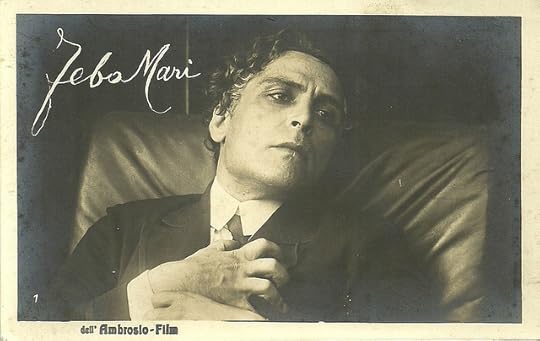
Febo Mari . Italian postcard by La Rotofotografica, no. 1. Photo: Ambrosio-Film.
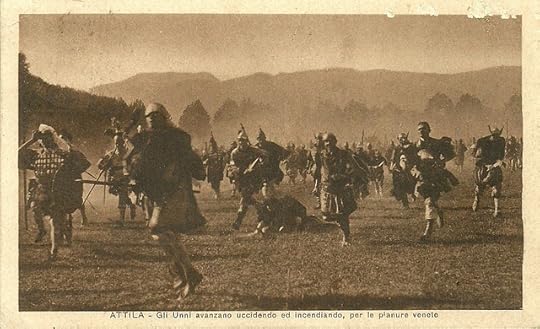
Italian postcard for the Ambrosio film Attila (1918). Translation caption: "The Huns advance while killing and burning all over the Venetian plains".
Attila the Hun
Who was the historic Attila? He was the ruler of the Huns from 434 until his death in 453. Attila was leader of the Hunnic Empire, which stretched from the Ural River to the Rhine River and from the Danube River to the Baltic Sea.
During his reign he was one of the most feared enemies of the Western and Eastern Roman Empires. He crossed the Danube twice and plundered the Balkans, but was unable to take Constantinople.
He also attempted to conquer Roman Gaul (modern France), crossing the Rhine in 451 and marching as far as Aurelianum (Orléans) before being defeated at the Battle of the Catalaunian Plains.
Subsequently he invaded Italy, devastating the northern provinces, but was unable to take Rome. He planned for further campaigns against the Romans but died in 453.
In legend he appears under the name
Like Pier da Castello, the British magazine Bioscope showed the same permissiveness in their 1918 review of Attila, justifying Febo Mari ’s spectacle but also its ideological warning against ‘barbarians’ then and now.
Bioscope also praised the beauty of the two leading actresses, newcomer Roasio and Ileana Leonidoff as the sensual Bulgarian dancer Ildico – who according to Bioscope had been the real assassin of Attila.
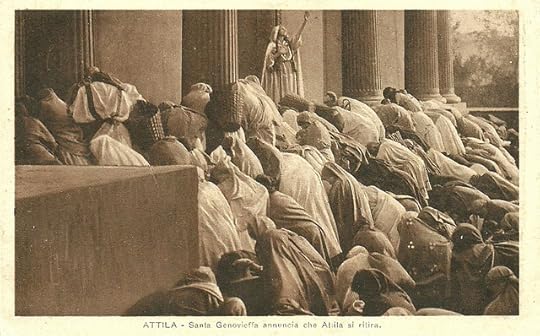
Italian postcard for the Ambrosio film Attila (1918). Translation caption: "Saint Genevieve announces that Attila is retreating".
Source: Encyclopaedia Britannica, Wikipedia and IMDb.

Italian postcard for Attila (1918). Translation caption: 'The torture of a girl by orders of Attila'.
The Scourge of God
On IMDb , there are two lemmas for Attila (1918) and Attila, il flagello di Dio/Attila, the Scourge of God (1918), but both refer to the same film. Flagellum Dei (Latin for Scourge of God) was the byname of the barbarian conqueror.
Italian silent film star Febo Mari not only starred in and directed the Peplum for Società Anonima Ambrosio, but he also wrote the script.
Producer Arturo Ambrosio ordered impressive sets, which were designed by Pietro Canonica, Ettore Ridoni and Carlo Stratta.
Among Febo Mari 's co-stars were the diva Ileana Leonidoff as Ildico, Nietta Mordeglia as Creca and Maria Roasio as Onoria.
Roasio made her film debut here as Onoria, the Roman woman who is given to Attila because he spared the destruction of Rome. But she kills him in their wedding night.
The film came out in Italy in February 1918, during the First World War. Pier da Castello in the Italian magazine La vita cinematografica drew a comparison between Attila the Hun and Emperor Wilhelm II, who was considered as the culprit of the First World War and its massive slaughter.
Da Castello indicated that Mari’s film appealed to the call of the government to make patriotic films. These must show audiences why the blood-shedding was necessary. He forgave Mari’s ‘playing’ with history.

Febo Mari . Italian postcard by La Rotofotografica, no. 1. Photo: Ambrosio-Film.

Italian postcard for the Ambrosio film Attila (1918). Translation caption: "The Huns advance while killing and burning all over the Venetian plains".
Attila the Hun
Who was the historic Attila? He was the ruler of the Huns from 434 until his death in 453. Attila was leader of the Hunnic Empire, which stretched from the Ural River to the Rhine River and from the Danube River to the Baltic Sea.
During his reign he was one of the most feared enemies of the Western and Eastern Roman Empires. He crossed the Danube twice and plundered the Balkans, but was unable to take Constantinople.
He also attempted to conquer Roman Gaul (modern France), crossing the Rhine in 451 and marching as far as Aurelianum (Orléans) before being defeated at the Battle of the Catalaunian Plains.
Subsequently he invaded Italy, devastating the northern provinces, but was unable to take Rome. He planned for further campaigns against the Romans but died in 453.
In legend he appears under the name
Like Pier da Castello, the British magazine Bioscope showed the same permissiveness in their 1918 review of Attila, justifying Febo Mari ’s spectacle but also its ideological warning against ‘barbarians’ then and now.
Bioscope also praised the beauty of the two leading actresses, newcomer Roasio and Ileana Leonidoff as the sensual Bulgarian dancer Ildico – who according to Bioscope had been the real assassin of Attila.

Italian postcard for the Ambrosio film Attila (1918). Translation caption: "Saint Genevieve announces that Attila is retreating".
Source: Encyclopaedia Britannica, Wikipedia and IMDb.
Published on December 13, 2013 23:00
December 12, 2013
Daniel Olbrychski
Today, it's Postcard Friendship Friday on the net. A weekly event in which postcard blogs present themselves. Start at Beth's blog with the great title
The Best Hearts Are Crunchy
, and enjoy some rare vintage postcards that are preserved on the net by bloggers like me.
For this Postcard Friendship Friday, I have chosen postcards of handsome and athletic Daniel Olbrychski (1945), a Polish actor best known for his leading roles in several Andrzej Wajda films. He also worked with Volker Schlöndorff, Krzysztof Kieślowski, Claude Lelouch and recently he played Russian defector and spymaster Vassily Orlov opposite Angelina Jolie in the Hollywood blockbuster Salt (2011).
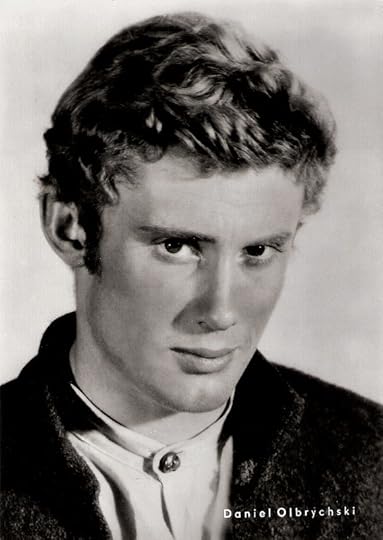
East-German postcard by VEB Progress Filmvertrieb, Berlin, no. 117/73, 1973. Retail price: 0,20 M.
Andrzej Wajda
Daniel Marcel Olbrychski was born in Łowicz, Poland in 1945 as the son of Franciszka Olbrychski and Klementyny Sołonowicz-Olbrychski. He attended the Gimnazjum i Liceum im. Stefana Batorego in Warsaw.
In the years 1963 and 1964 he performed at the Teatrem Młodzieżowym TVP (Youth Theatre) under the direction of Andrzeja Konica. He started to attend the Państwowa Wyższa Szkoła Teatralna (Academy of Dramatic Arts in Warsaw), but never finished his studies.
In 1964 his film career started at the age of 18 with the war film Ranny w lesie/Wounded in the Forest (Janusz Nasfeter, 1964).
A year later, he worked for the first time with director Andrzej Wajda at the Western-style war epic Popioły/The Ashes (Andrzej Wajda, 1965) which was entered into the 1966 Cannes Film Festival. He also appeared in Wajda’s Wszystko na sprzedaż/Everything for Sale (Andrzej Wajda, 1969) with Beata Tyszkiewicz, and the comedy Polowanie na muchy/Hunting Flies (Andrzej Wajda, 1969).
He then had the lead in the drama Życie rodzinne/Family Life (Krzysztof Zanussi, 1971).
He starred in the drama Krajobraz po bitwie/Landscape After the Battle (Andrzej Wajda, 1970), the story of a Nazi German concentration camp survivor soon after liberation, residing in a DP camp somewhere in Germany. The film is based on the writings of Holocaust survivor and Polish author Tadeusz Borowski.
Olbrychski also starred in the drama Brzezina/The Birch Wood (Andrzej Wajda, 1970) based on a novel by Jarosław Iwaszkiewicz. It was entered into the 7th Moscow International Film Festival where Andrzej Wajda won the Golden Prize for Direction and Daniel Olbrychski won the award for Best Actor.
They also worked together on the German drama Pilatus und andere - Ein Film für Karfreitag/Pilate and Others (Andrzej Wajda, 1972), based on the 1967 novel The Master and Margarita by the Soviet writer Mikhail Bulgakov.
Then followed Wesele/The Wedding (Andrzej Wajda, 1972), an adaptation of a play by Stanisław Wyspiański which Wajda also directed for the theatre. Wesele describes the perils of the national drive toward self-determination after the Polish uprisings of November 1830 and January 1863, the result of the Partitions of Poland.
Ziemia Obiecana/The Promised Land (Andrzej Wajda, 1975) is a drama based on a novel by Władysław Reymont. Set in the industrial city of Łódź, The Promised Land tells the story of a Pole, a German, and a Jew struggling to build a factory in the raw world of 19th century capitalism.
Very popular was the Polish-Soviet historical drama Potop/The Deluge (Jerzy Hoffman, 1974), based on the 1886 novel by Henryk Sienkiewicz. It was nominated for the Academy Award for Best Foreign Language Film at the 47th Academy Awards, but lost to Amarcord (Federico Fellini, 1973). The film is the third most popular in the history of Polish cinema, with some 28 million tickets sold in Poland and 30.5 million in the Soviet Union.
Olbrychski also starred in Panny z Wilka/The Maids of Wilko (Andrzej Wajda, 1979), which was nominated for the Academy Award for Best Foreign Language Film.
Daniel Olbruchski then played one of the leads in Volker Schlöndorff's masterpiece Die Blechtrommel/The Tin Drum (1979) based on Günter Grass' novel. The Tin Drum was one of the most financially successful German films of the 1970s. It won the 1979 Academy Award for Best Foreign Language Film and was jointly awarded the Palme d'Or at the 1979 Cannes Film Festival, along with Apocalypse Now (Francis Ford Coppola, 1979).
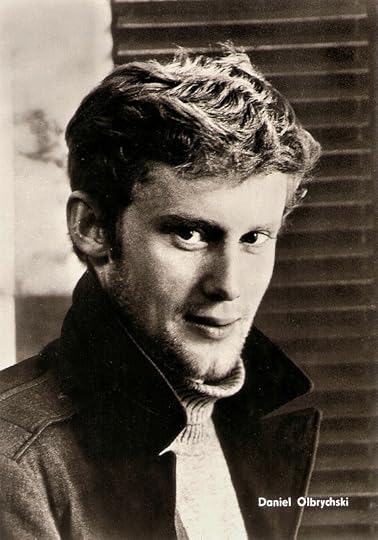
East-German postcard by VEB Progress Filmvertrieb, Berlin, no. 3191, 1968. Retail price: 0,20 M. Photo: Balinski.
Hot-Tempered Patriot
IMDb describes Daniel Olbrychski as a ‘hot-tempered patriot’, who would enjoy horseback riding on town centre squares. Another amusing anecdote is that once a picture of Olbrychski as an SS-man was displayed in a contemporary art exhibition. As soon as he knew this, he went armed with a saber and with a TV news crew to the exhibition room, where he cut down his portrait, ending its existence.
In the 1980s, he gradually switched from leads to supporting roles. He appeared in the popular French musical epic Les Uns et les Autres/Bolero: Dance of Life (Claude Lelouch, 1981).
Other West-European films include La Truite/The Trout (Joseph Losey, 1982), starring Isabelle Huppert , Eine Liebe in Deutschland/A Love in Germany (Andrzej Wajda, 1983) with Hanna Schygulla, and Die Geduld der Rosa Luxemburg/Rosa Luxemburg (Margarethe von Trotta, 1986) featuring Barbara Sukowa.
Rosa Luxemburg received the German Film Award (Bundesfilmpreis) as best feature film. In 1986 Olbrychski received the French L'Ordre national de la Légion d'honneur (Legion of Honor).
In Italy, he made the drama Mosca addio/Farewell Moscow (Mauro Bolognini, 1987) based on the life of Russian Jew Ida Nudel. For this film Liv Ullmann was awarded with a David di Donatello for Best Actress.
He then had his American debut in The Unbearable Lightness of Being (Philip Kaufman, 1988), the successful film adaptation of the novel by Milan Kundera starring Daniel Day Lewis.
He also appeared in the third of the ten episodes in Krzysztof Kieślowski's classic Polish TV series Dekalog/The Decalogue (1988).
His films during the 1990s were less prominent. He had a part in the Polish historical drama Ogniem i Mieczem/With Fire and Sword (Jerzy Hoffman, 1999) based on a novel by Henryk Sienkiewicz and starring ‘Bond girl’ Izabella Scorupco. At the time of its filming it was the most expensive Polish film ever made.
Olbrychski and Wajda reunited for Pan Tadeusz/Pan Tadeusz: The Last Foray in Lithuania (Andrzej Wajda, 1999), based on the epic poem by Polish poet, writer and philosopher Adam Mickiewicz, and for the comedy Zemsta/The Revenge (Andrzej Wajda, 2002), an adaptation of a popular stage farce of Aleksander Fredro with director Roman Polanski in the lead role.
In 2007 Olbrychski received the Stanislavsky Award at the 29th Moscow International Film Festival for the outstanding achievement in the career of acting and devotion to the principles of Stanislavsky's school. Remarkable was his part as the sinister Russian defector who accuses Angelina Jolie to be a Russian spy in the American action thriller Salt (Philip Noyce, 2010).
Since then he appeared in the German film Wintertochter (Johannes Schmid, 2011), the Polish historical film Bitwa warszawska 1920/Battle of Warsaw 1920 (Jerzy Hoffman, 2011) and in the Russian production Legenda No. 17/ Legend No. 17 (Nikolay Lebedev, 2013), a biopic of Russian ice hockey legend Valeri Kharlamov (played by Danila Kozlovsky).
Daniel Olbrychski married three times. His first wife was Monika Dzienisiewicz-Olbrychska (1967-1977), with whom he has a son, actor Rafał Olbrychski (1971). His second wife was Zuzanna Lapicka (1978-1988) with whom he has a daughter Weronika (1982). Since 2003 he is married to Krystyna Demska. He is also the father of Viktor Sukowa, from a relationship with German actress Barbara Sukowa. In the mid-1970s he had a 3-year relationship with singer Maryla Rodowicz.
Trailer Krajobraz po bitwie/Landscape After the Battle (1970). Source: Movie Trailers (YouTube).
Trailer Salt (2010). Source: eLearnable123 (YouTube).
Sources: Sandra Brennan (AllMovie), Film Polski (Polish), Wikipedia (English and Polish) and IMDb.
For this Postcard Friendship Friday, I have chosen postcards of handsome and athletic Daniel Olbrychski (1945), a Polish actor best known for his leading roles in several Andrzej Wajda films. He also worked with Volker Schlöndorff, Krzysztof Kieślowski, Claude Lelouch and recently he played Russian defector and spymaster Vassily Orlov opposite Angelina Jolie in the Hollywood blockbuster Salt (2011).

East-German postcard by VEB Progress Filmvertrieb, Berlin, no. 117/73, 1973. Retail price: 0,20 M.
Andrzej Wajda
Daniel Marcel Olbrychski was born in Łowicz, Poland in 1945 as the son of Franciszka Olbrychski and Klementyny Sołonowicz-Olbrychski. He attended the Gimnazjum i Liceum im. Stefana Batorego in Warsaw.
In the years 1963 and 1964 he performed at the Teatrem Młodzieżowym TVP (Youth Theatre) under the direction of Andrzeja Konica. He started to attend the Państwowa Wyższa Szkoła Teatralna (Academy of Dramatic Arts in Warsaw), but never finished his studies.
In 1964 his film career started at the age of 18 with the war film Ranny w lesie/Wounded in the Forest (Janusz Nasfeter, 1964).
A year later, he worked for the first time with director Andrzej Wajda at the Western-style war epic Popioły/The Ashes (Andrzej Wajda, 1965) which was entered into the 1966 Cannes Film Festival. He also appeared in Wajda’s Wszystko na sprzedaż/Everything for Sale (Andrzej Wajda, 1969) with Beata Tyszkiewicz, and the comedy Polowanie na muchy/Hunting Flies (Andrzej Wajda, 1969).
He then had the lead in the drama Życie rodzinne/Family Life (Krzysztof Zanussi, 1971).
He starred in the drama Krajobraz po bitwie/Landscape After the Battle (Andrzej Wajda, 1970), the story of a Nazi German concentration camp survivor soon after liberation, residing in a DP camp somewhere in Germany. The film is based on the writings of Holocaust survivor and Polish author Tadeusz Borowski.
Olbrychski also starred in the drama Brzezina/The Birch Wood (Andrzej Wajda, 1970) based on a novel by Jarosław Iwaszkiewicz. It was entered into the 7th Moscow International Film Festival where Andrzej Wajda won the Golden Prize for Direction and Daniel Olbrychski won the award for Best Actor.
They also worked together on the German drama Pilatus und andere - Ein Film für Karfreitag/Pilate and Others (Andrzej Wajda, 1972), based on the 1967 novel The Master and Margarita by the Soviet writer Mikhail Bulgakov.
Then followed Wesele/The Wedding (Andrzej Wajda, 1972), an adaptation of a play by Stanisław Wyspiański which Wajda also directed for the theatre. Wesele describes the perils of the national drive toward self-determination after the Polish uprisings of November 1830 and January 1863, the result of the Partitions of Poland.
Ziemia Obiecana/The Promised Land (Andrzej Wajda, 1975) is a drama based on a novel by Władysław Reymont. Set in the industrial city of Łódź, The Promised Land tells the story of a Pole, a German, and a Jew struggling to build a factory in the raw world of 19th century capitalism.
Very popular was the Polish-Soviet historical drama Potop/The Deluge (Jerzy Hoffman, 1974), based on the 1886 novel by Henryk Sienkiewicz. It was nominated for the Academy Award for Best Foreign Language Film at the 47th Academy Awards, but lost to Amarcord (Federico Fellini, 1973). The film is the third most popular in the history of Polish cinema, with some 28 million tickets sold in Poland and 30.5 million in the Soviet Union.
Olbrychski also starred in Panny z Wilka/The Maids of Wilko (Andrzej Wajda, 1979), which was nominated for the Academy Award for Best Foreign Language Film.
Daniel Olbruchski then played one of the leads in Volker Schlöndorff's masterpiece Die Blechtrommel/The Tin Drum (1979) based on Günter Grass' novel. The Tin Drum was one of the most financially successful German films of the 1970s. It won the 1979 Academy Award for Best Foreign Language Film and was jointly awarded the Palme d'Or at the 1979 Cannes Film Festival, along with Apocalypse Now (Francis Ford Coppola, 1979).

East-German postcard by VEB Progress Filmvertrieb, Berlin, no. 3191, 1968. Retail price: 0,20 M. Photo: Balinski.
Hot-Tempered Patriot
IMDb describes Daniel Olbrychski as a ‘hot-tempered patriot’, who would enjoy horseback riding on town centre squares. Another amusing anecdote is that once a picture of Olbrychski as an SS-man was displayed in a contemporary art exhibition. As soon as he knew this, he went armed with a saber and with a TV news crew to the exhibition room, where he cut down his portrait, ending its existence.
In the 1980s, he gradually switched from leads to supporting roles. He appeared in the popular French musical epic Les Uns et les Autres/Bolero: Dance of Life (Claude Lelouch, 1981).
Other West-European films include La Truite/The Trout (Joseph Losey, 1982), starring Isabelle Huppert , Eine Liebe in Deutschland/A Love in Germany (Andrzej Wajda, 1983) with Hanna Schygulla, and Die Geduld der Rosa Luxemburg/Rosa Luxemburg (Margarethe von Trotta, 1986) featuring Barbara Sukowa.
Rosa Luxemburg received the German Film Award (Bundesfilmpreis) as best feature film. In 1986 Olbrychski received the French L'Ordre national de la Légion d'honneur (Legion of Honor).
In Italy, he made the drama Mosca addio/Farewell Moscow (Mauro Bolognini, 1987) based on the life of Russian Jew Ida Nudel. For this film Liv Ullmann was awarded with a David di Donatello for Best Actress.
He then had his American debut in The Unbearable Lightness of Being (Philip Kaufman, 1988), the successful film adaptation of the novel by Milan Kundera starring Daniel Day Lewis.
He also appeared in the third of the ten episodes in Krzysztof Kieślowski's classic Polish TV series Dekalog/The Decalogue (1988).
His films during the 1990s were less prominent. He had a part in the Polish historical drama Ogniem i Mieczem/With Fire and Sword (Jerzy Hoffman, 1999) based on a novel by Henryk Sienkiewicz and starring ‘Bond girl’ Izabella Scorupco. At the time of its filming it was the most expensive Polish film ever made.
Olbrychski and Wajda reunited for Pan Tadeusz/Pan Tadeusz: The Last Foray in Lithuania (Andrzej Wajda, 1999), based on the epic poem by Polish poet, writer and philosopher Adam Mickiewicz, and for the comedy Zemsta/The Revenge (Andrzej Wajda, 2002), an adaptation of a popular stage farce of Aleksander Fredro with director Roman Polanski in the lead role.
In 2007 Olbrychski received the Stanislavsky Award at the 29th Moscow International Film Festival for the outstanding achievement in the career of acting and devotion to the principles of Stanislavsky's school. Remarkable was his part as the sinister Russian defector who accuses Angelina Jolie to be a Russian spy in the American action thriller Salt (Philip Noyce, 2010).
Since then he appeared in the German film Wintertochter (Johannes Schmid, 2011), the Polish historical film Bitwa warszawska 1920/Battle of Warsaw 1920 (Jerzy Hoffman, 2011) and in the Russian production Legenda No. 17/ Legend No. 17 (Nikolay Lebedev, 2013), a biopic of Russian ice hockey legend Valeri Kharlamov (played by Danila Kozlovsky).
Daniel Olbrychski married three times. His first wife was Monika Dzienisiewicz-Olbrychska (1967-1977), with whom he has a son, actor Rafał Olbrychski (1971). His second wife was Zuzanna Lapicka (1978-1988) with whom he has a daughter Weronika (1982). Since 2003 he is married to Krystyna Demska. He is also the father of Viktor Sukowa, from a relationship with German actress Barbara Sukowa. In the mid-1970s he had a 3-year relationship with singer Maryla Rodowicz.
Trailer Krajobraz po bitwie/Landscape After the Battle (1970). Source: Movie Trailers (YouTube).
Trailer Salt (2010). Source: eLearnable123 (YouTube).
Sources: Sandra Brennan (AllMovie), Film Polski (Polish), Wikipedia (English and Polish) and IMDb.
Published on December 12, 2013 23:00
Paul van Yperen's Blog
- Paul van Yperen's profile
- 13 followers
Paul van Yperen isn't a Goodreads Author
(yet),
but they
do have a blog,
so here are some recent posts imported from
their feed.



